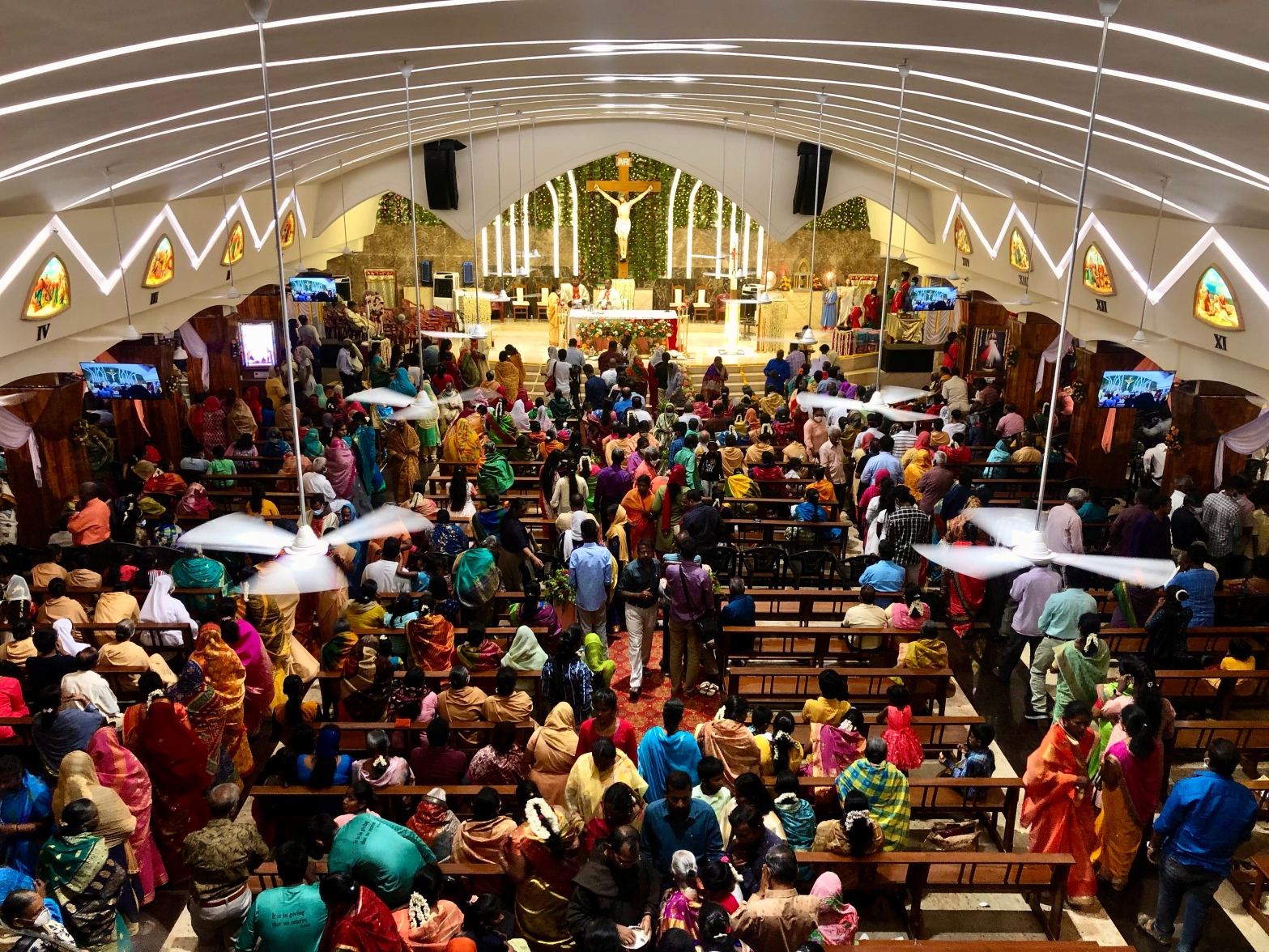During the last dregs of Palm Sunday, a technicolor pamphlet goes up on Facebook, tempered by a sober caption: “70th Feast of St. Sebastian. Madhavaram, Chennai. Welcome.” Awfully restrained for a platinum jubilee celebration sprawling eight consecutive days, but then Fr. Simon was never given to frills and frippery. He knows a simple, well-timed “Welcome” is as momentous as an “Open” sign blazing outside a superstore on Black Friday.
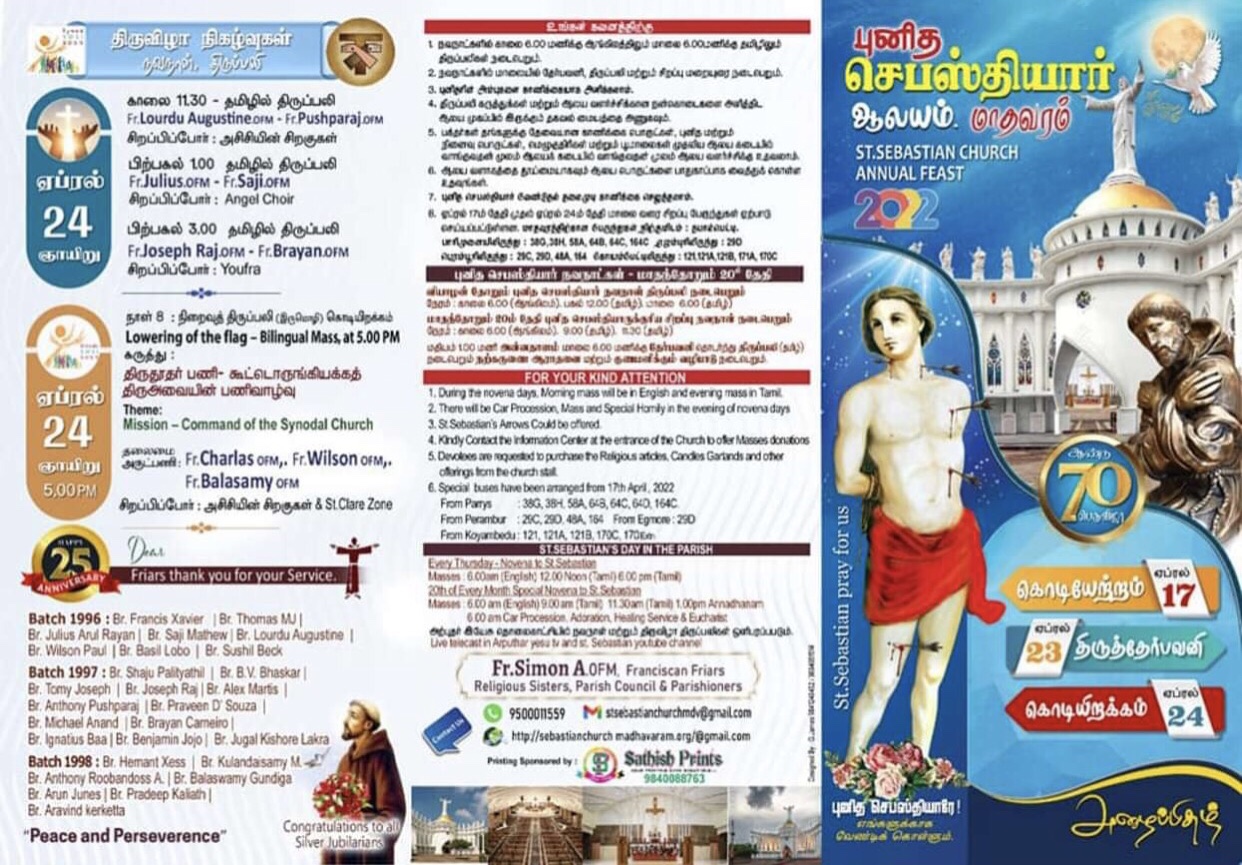
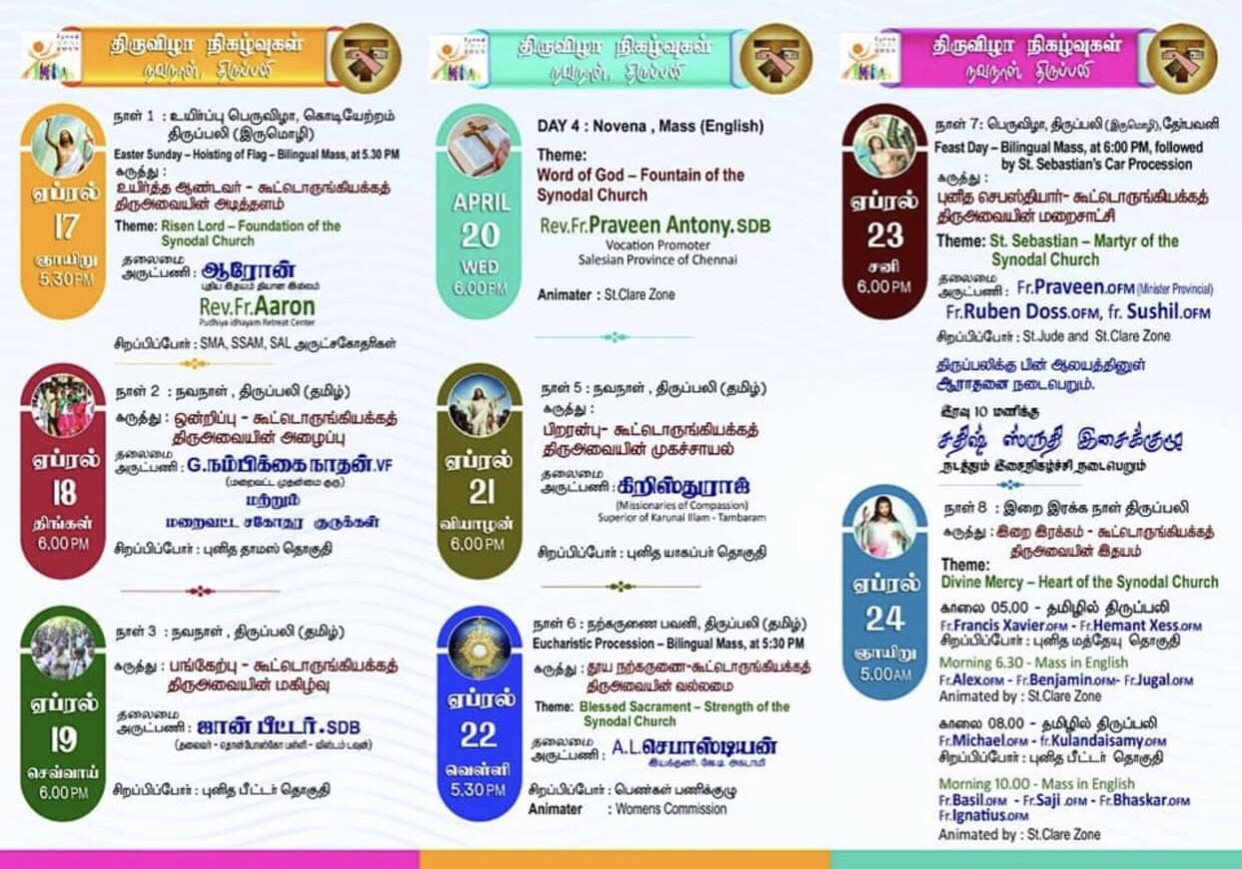
Lift ye up a banner (Isaiah 13:2)
Day 1: 17 April (Easter Sunday)
After a marathon of Easter masses, you’d expect the friars to be frazzled and fazed, but no. In a matter of hours, they roll out a red carpet, erect an LED effigy of St. Sebastian, and string chaser lights on trees and posts like neon garlands.
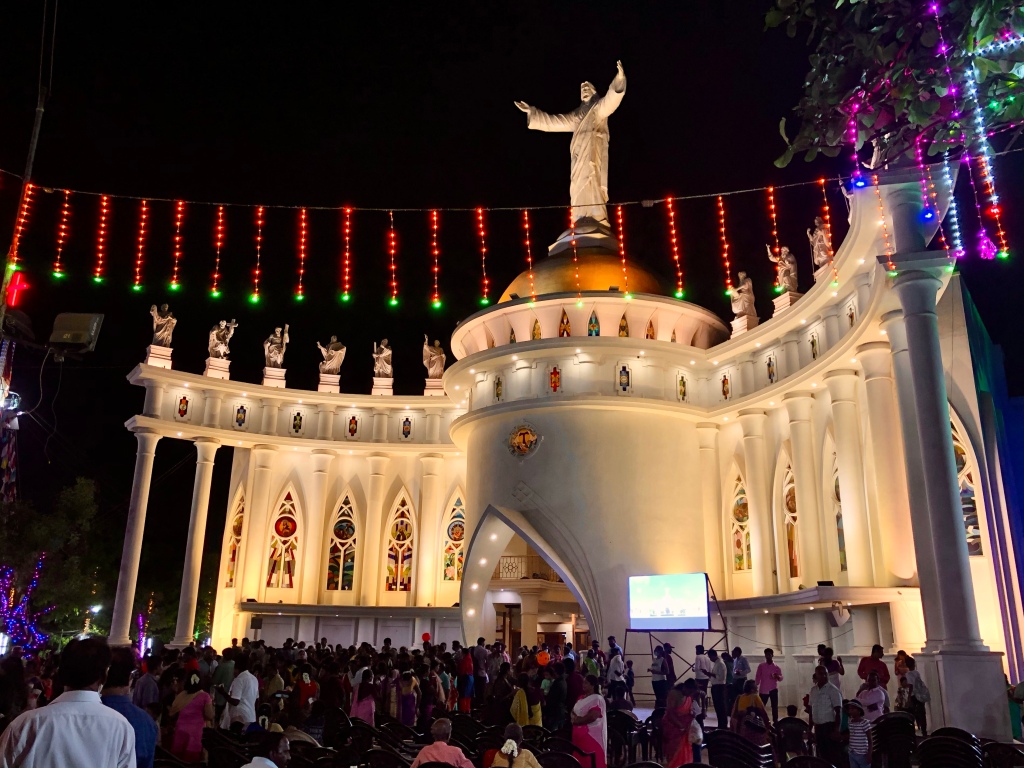
As for the parishioners, they are refreshed by the Easter felicity in the air. The austerities of Lent behind them, they’ve turned out in festive finery. Young hands clutch balloons and older hands thumb rosaries as they traverse the kilometer between St. Anne’s Generalate and the parish church.
At the head of the procession, a cassocked contingent bears a scarlet standard emblazoned with the image of the patron saint. As this solemn march past enters the church, the rumble of drums crescendoes, the bell peals, fireworks crackle.
A tuneful hymn to the saint plays on a loop and segues into fanfare as the flag rises skyward with everyone’s prayers.
Inside, sprays of fresh flowers hug the altar cloth as the Paschal candle burns deferentially.
The pews fill rapidly. The standees unstack plastic armchairs in the side aisles and unfurl mats before the altar. What follows is a two-hour mass with custom-made gold chasubles, nosefuls of frankincense, shimmering altar bells, and a stentorian sermon.
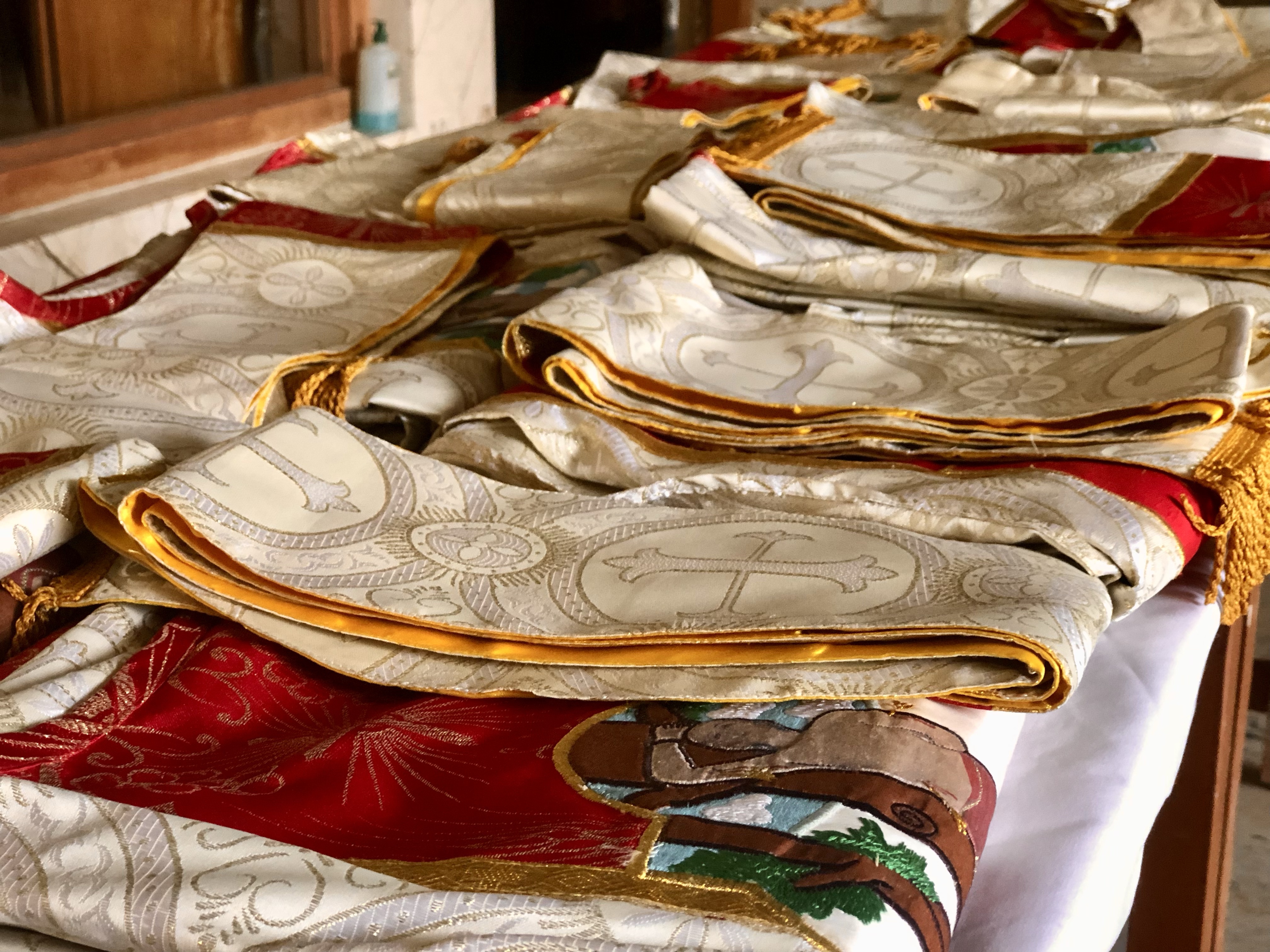
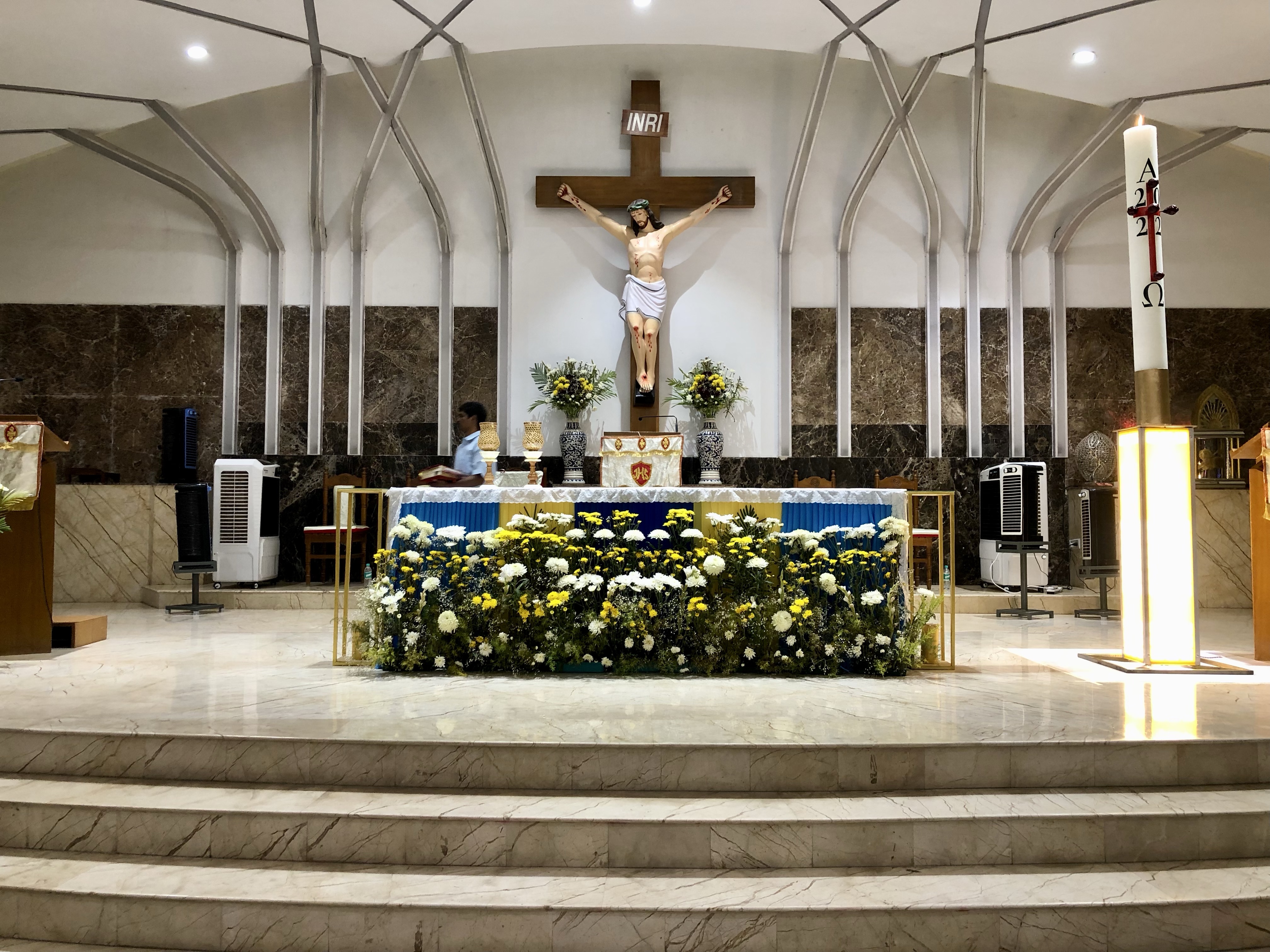
When mass concludes and darkness settles, the congregants bask in the ethereal glow of the frontage in amoebic clusters.
This is only the beginning.
With perfect heart they offered willingly (1 Chronicles 29:9)
Days 2-5: 18-21 April (Monday-Thursday)
During the intervening weekdays, in that fugitive mellow eventide, the rosary soundtracks abbreviated processions. Discordant pitches strangely mingle to yield a harmonious chant.
Cardboard boxes, bulging cloth bags, bloated plastic bags, and steel storage containers multiply at the foot of the altar till the space becomes narrowly distinguishable from my kitchen floor after the groceries arrive.
Outside, St. Sebastian is sheltered in a chariot, framed by lights, and laden with a rose garland. Devotees come—some in clutches, some in lines, some solo—to pray or simply touch his feet. Why he is revered and beloved you’ll soon see.
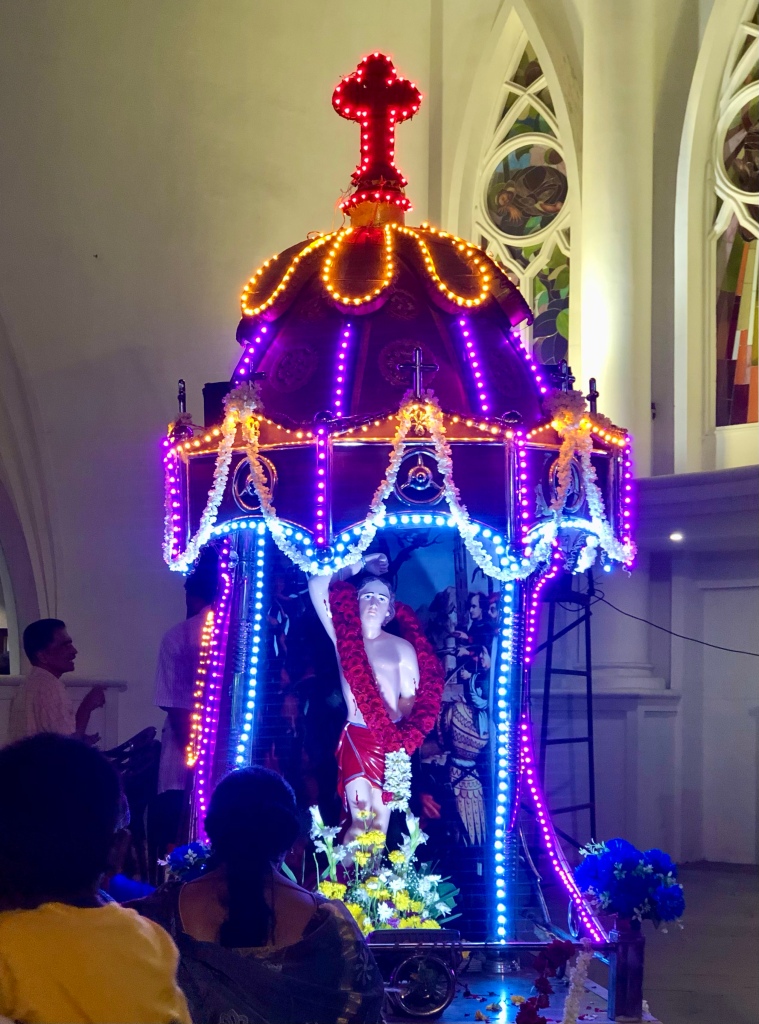
Culture and religion can co-opt Locard’s idea that “Every contact leaves a trace” to appreciate the syncretism that characterizes the feast. Vestiges of the Hindu practice of prasad are evident in the post-mass distribution of beverages, chana sundal, buns, and sweetmeats. The hymns to St. Sebastian feature Carnatic instrumentation.
In the true spirit of Indian hospitality, some folks leave St. Sebastian snack platters and cups of soda. Sadly, his hands are tied.
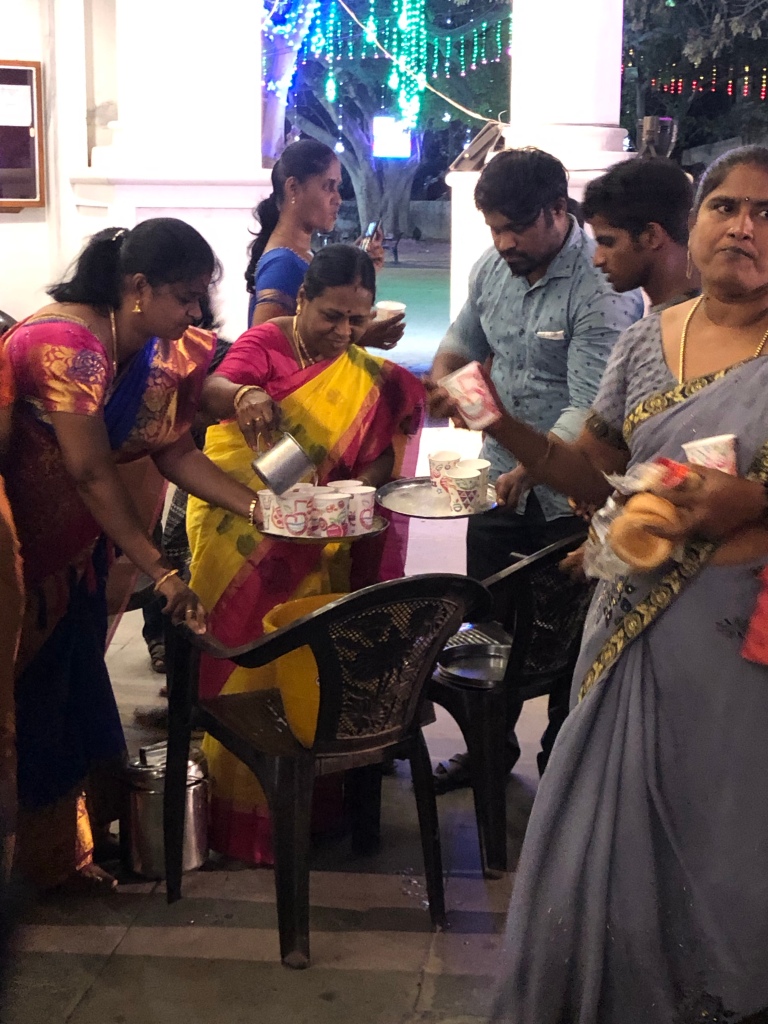
With the multitude… to the house of God (Psalms 42:4)
Day 6: 22 April (Friday)
Honeycomb cobblestones, intervaled palm trees, and clean-cut architecture make St. Anne’s Generalate a prime exemplar of symmetry and geometry.
The moment I walk in, I feel like someone fashioned a prism out of Fr. Simon’s pamphlet and shone a light through it. Leo Band, in their red-and-gold ensemble, rehearses snippets from their setlist; cops in khaki keep vigilance; the Legion of Mary, in sky blue and white, busy themselves with pretty flower girls in unicorn pastels; religious sisters in saffron and coral pink lead prayers; the Franciscans, in fifty shades of brown, perform their religious and organizational duties.

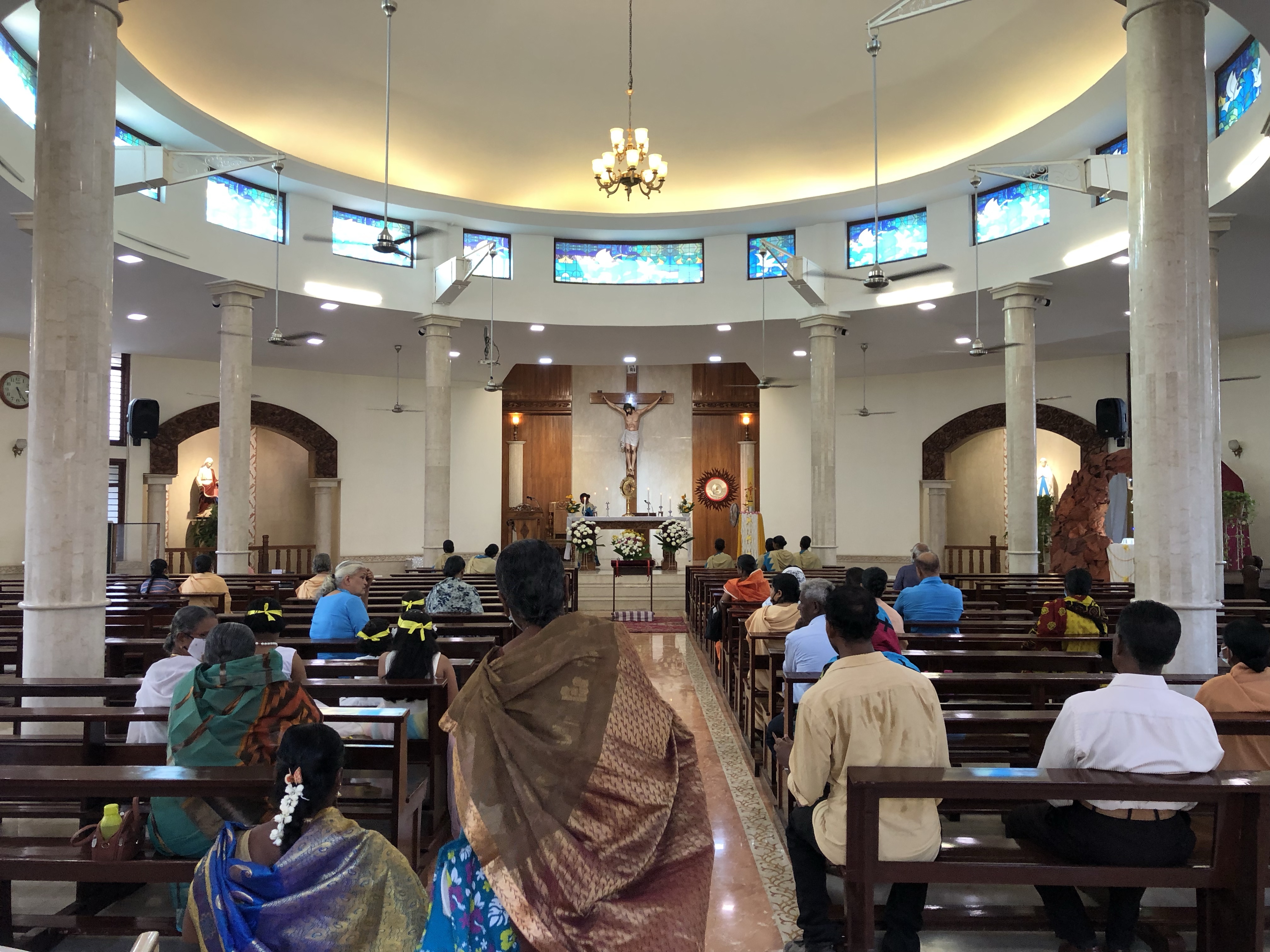
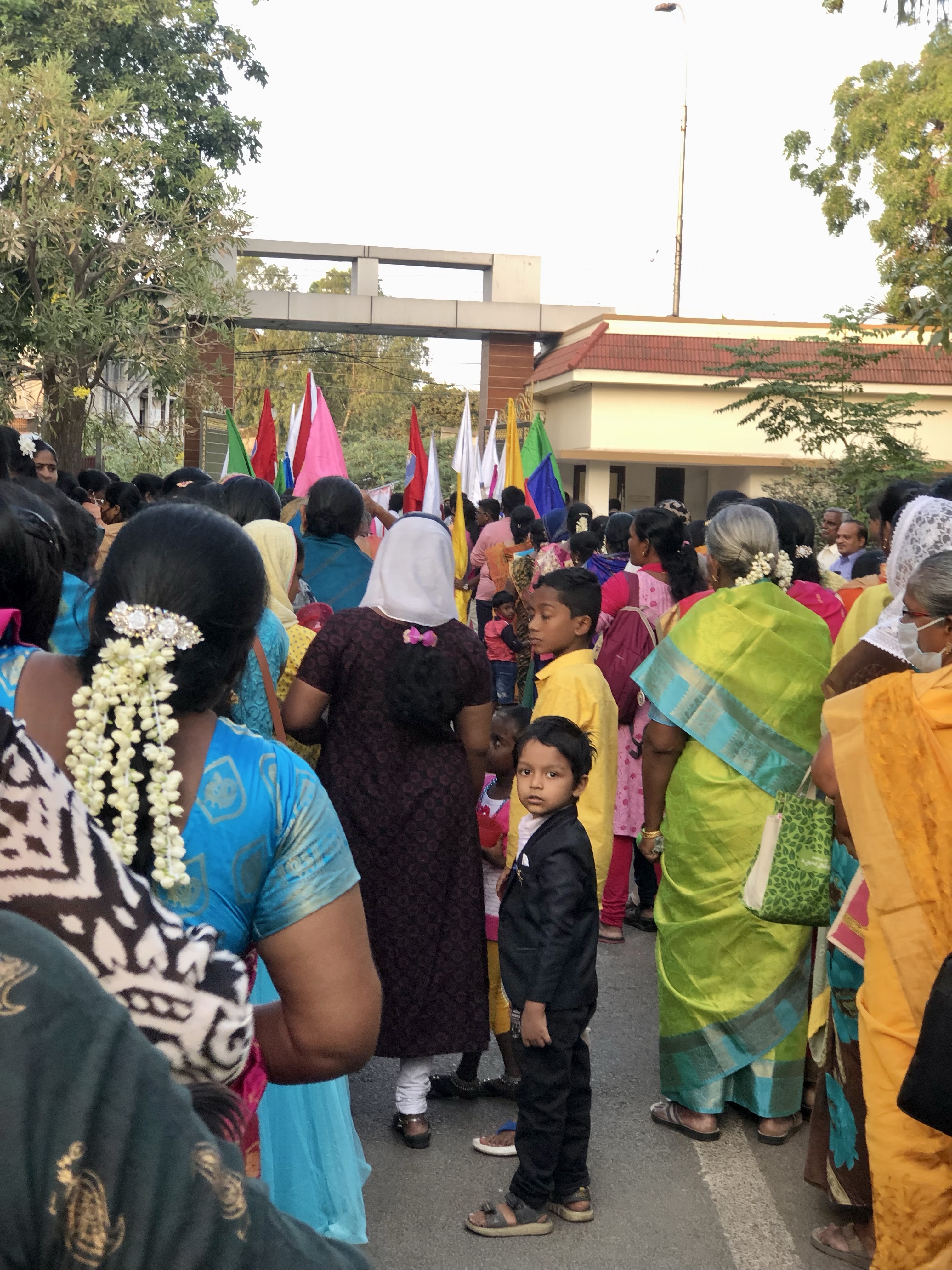
After the Eucharistic adoration and a litany of succession, Fr. Simon gives the ready-set-go. The sporadic masses fall into a pair of crooked, uneven lines behind the young flag bearers. For ethical, practical, and cultural reasons, we choose mini-trucks over donkeys to convey the monstrance and the sound system to the parish.
Traffic compromises, construction work halts, storekeepers stop and stare in between customers.
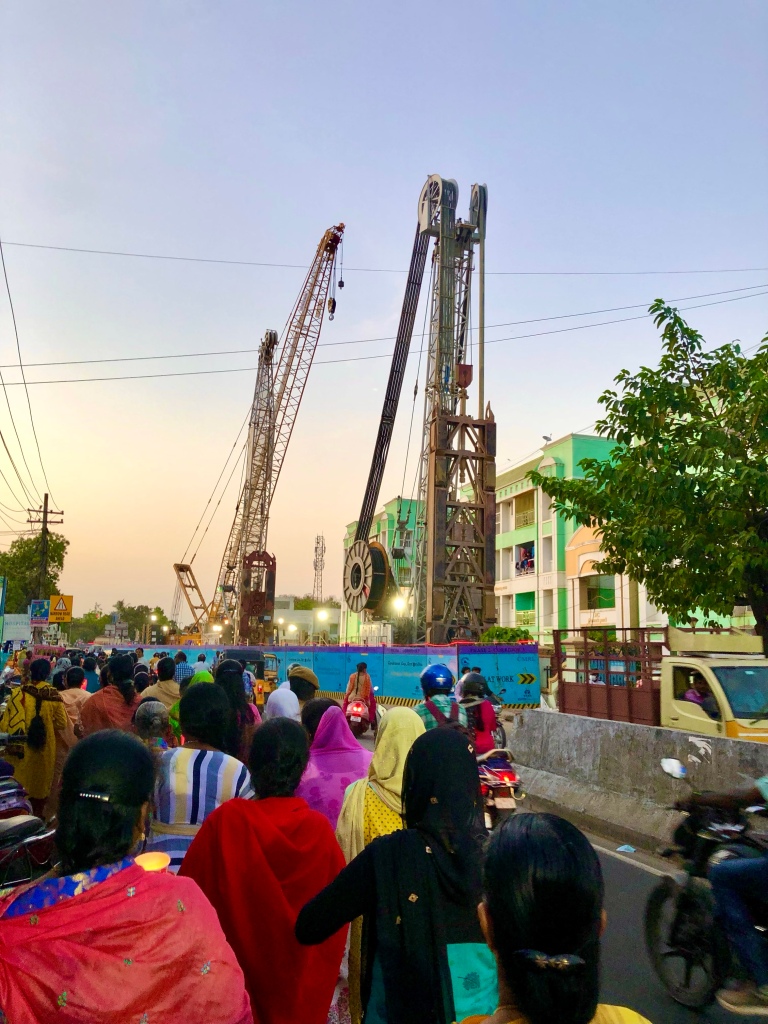
The mini-truck rolls past the church gate and into the midst of expectant Palm-Sunday-style crowds. Some experience the event with their eyes, and others through their phone screens, zealously capturing it for family, friends, Facebook, posterity, and unknown blogs. Those who hurry inside get the pews and the choicest views. Those who tarry outside watch the mass through panes of glass in the narthex.

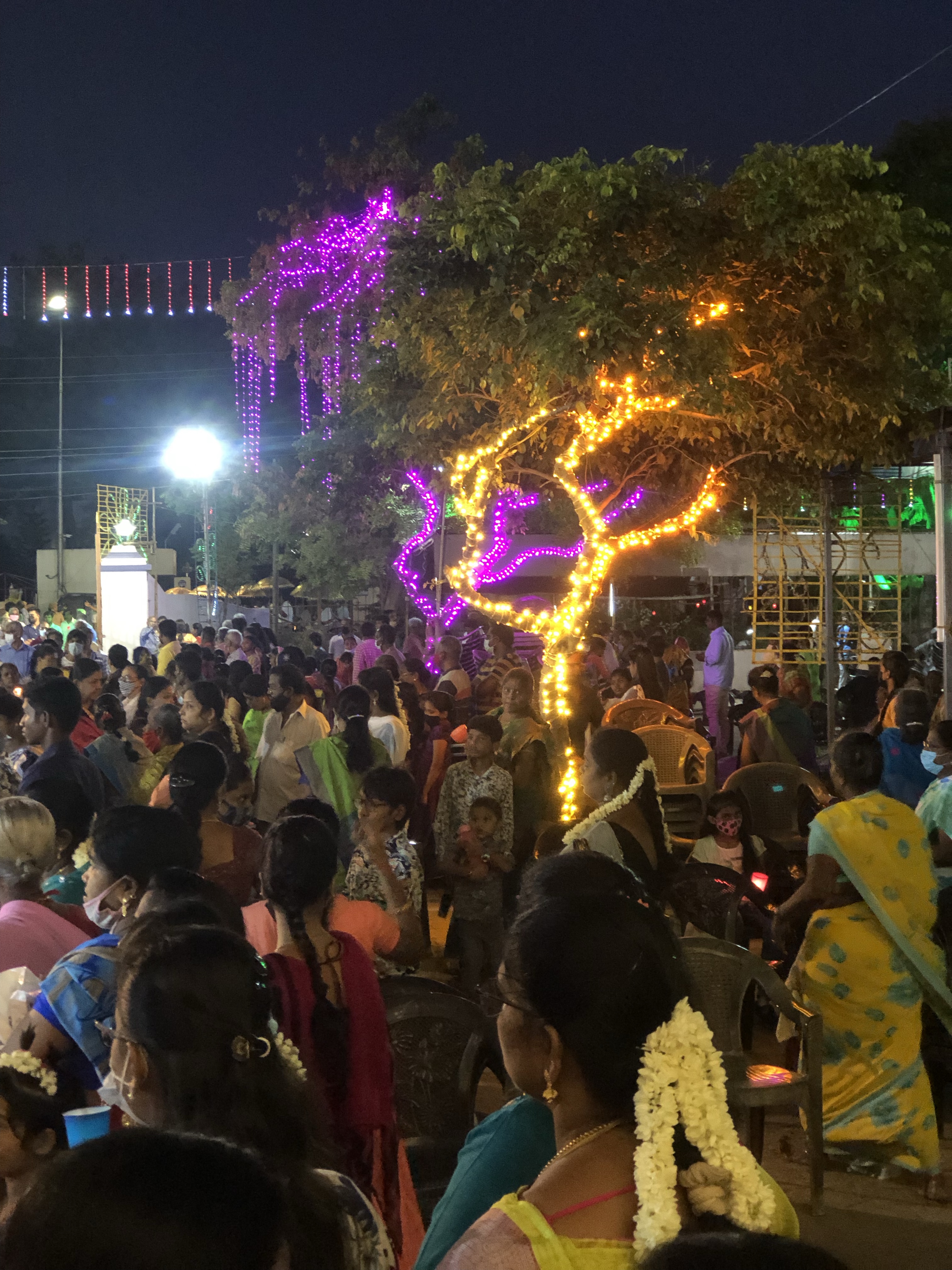
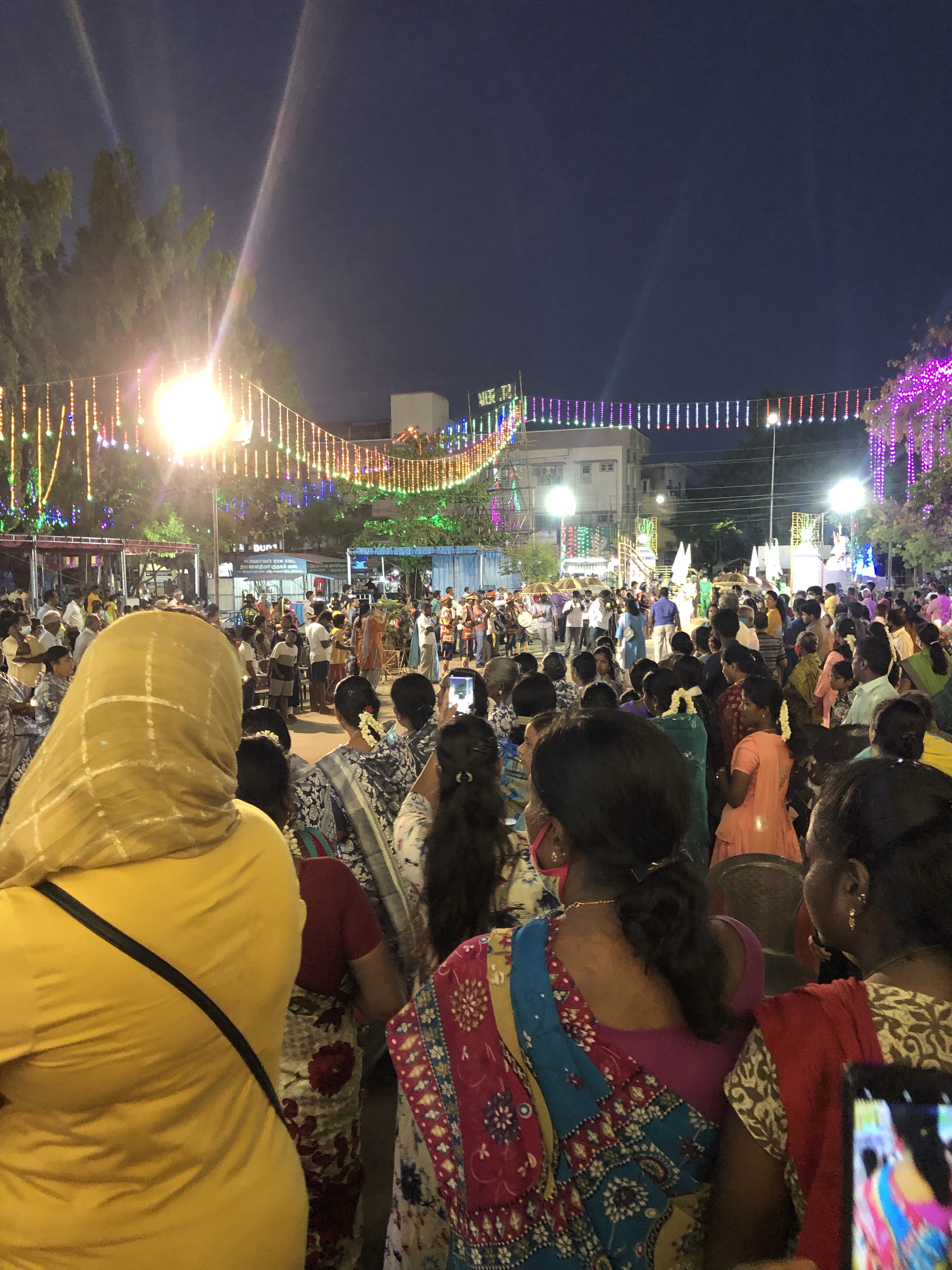
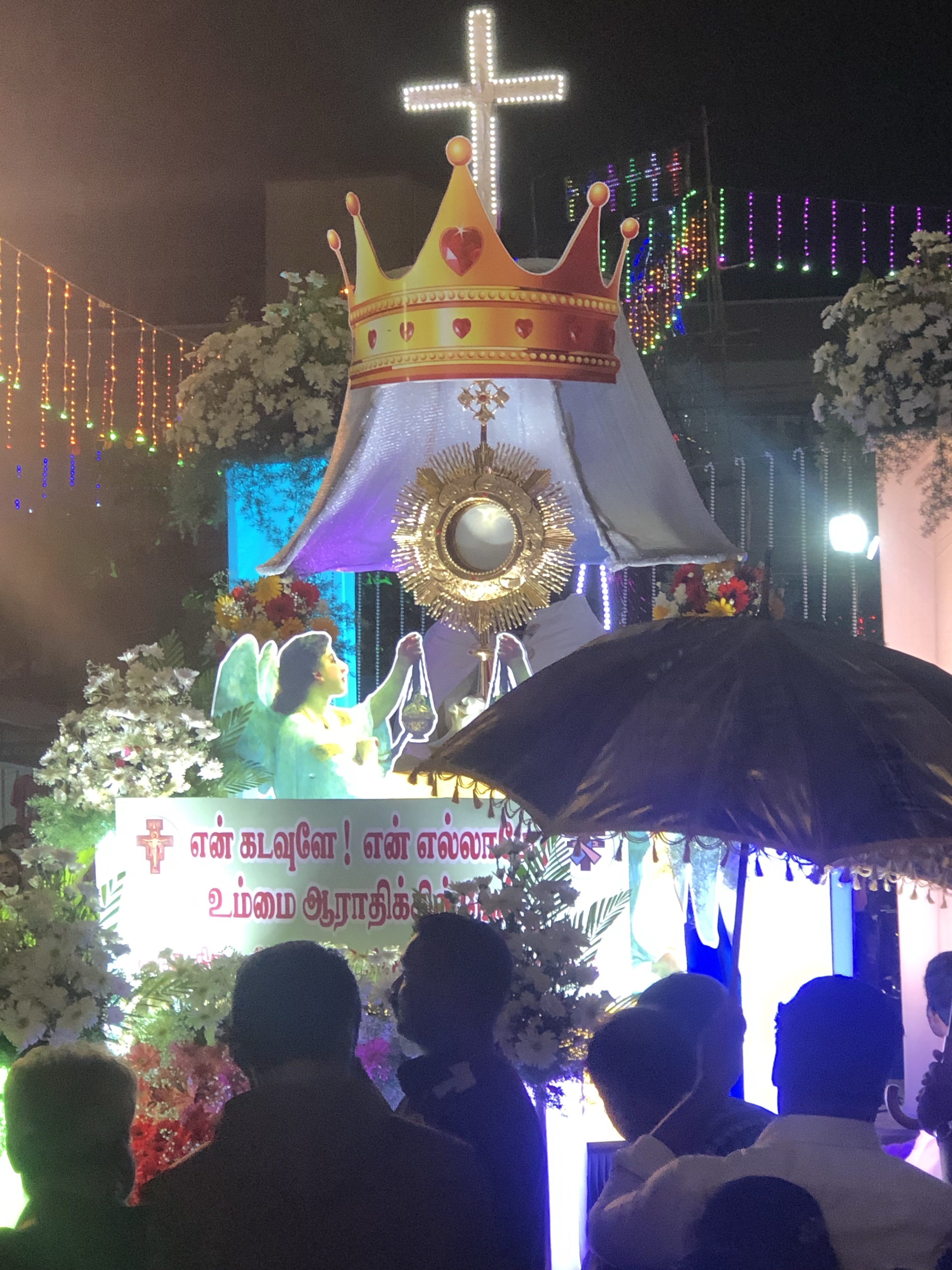
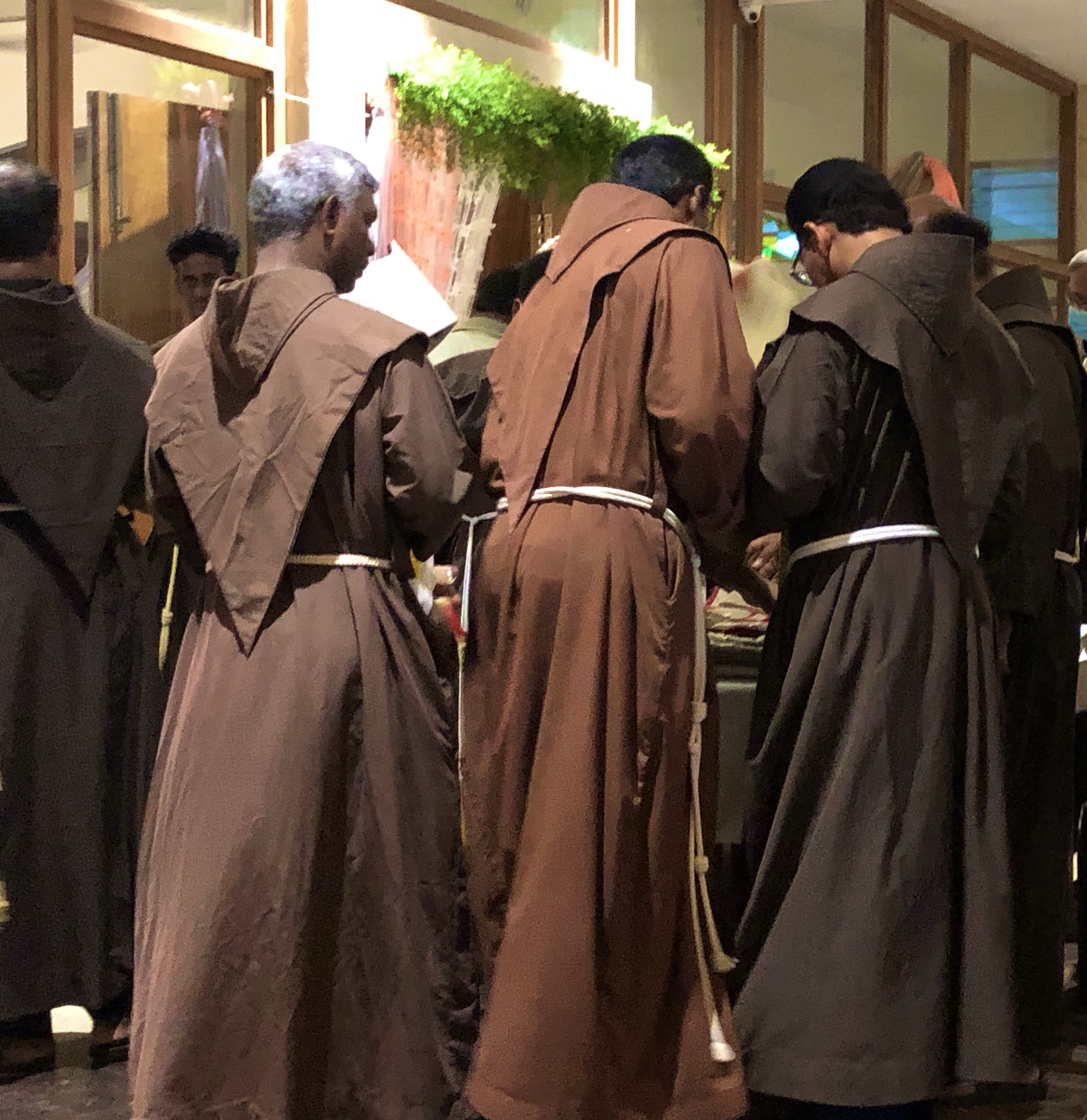
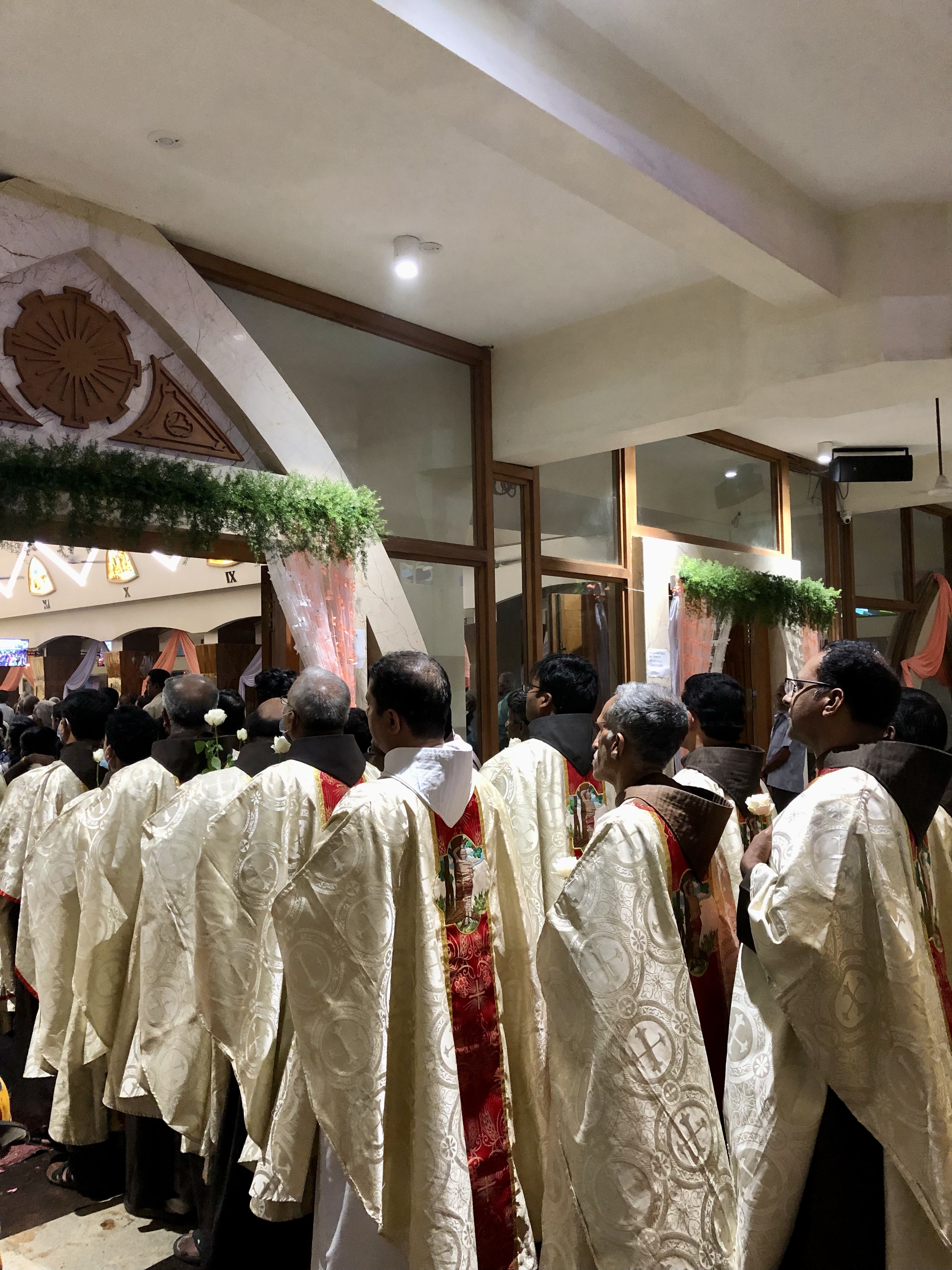
Order and chaos never looked so good together.
A spectacle unto the world and to angels and to men (1 Corinthians 4:9)
Day 7: 23 April (Saturday)
St. Sebastian’s Church is the crown jewel of this otherwise standard slice of suburbia. Its magnificent makeover increased its visibility and photogenicity, but the whys and wherefores of its popularity have more to do with its early history than its recent past.
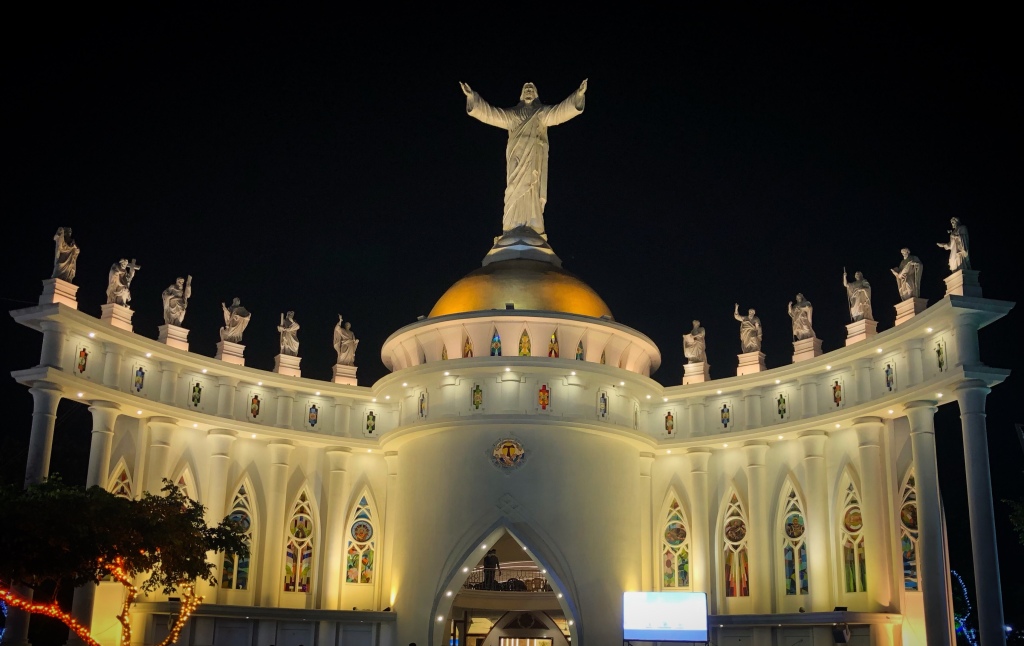
In the afternoon, when he could be catching his breath and a lunch break, Fr. Simon chooses to chat with an inquisitive wallflower. If being Parish Priest weren’t a full-time commitment, he could take up a side gig as a history teacher.
The story, a happy union of fact and folklore, begins in the church’s mango grove. The Salesians served the church in its dwarf days (1942–1953) before ceding it to the Franciscans (1953–present). Madha Koil became St. Sebastian’s Church.
The Franciscans reckoned a procession would give Sebastian the lay of the land and introduce him to the locals behind the grove, but they didn’t want the Roman youth with a mouthful of a name in their streets. An outbreak of chickenpox ensued which they promptly tied to their inhospitality. Whether the disease was coincidental or consequential, we’ll never know, but the locals desired to appease the saint. They requested the priests to bring his statue through the grove into their streets where they paid obeisance during a prayer service. After three days, they reported a series of miraculous healings. From then onward, Sebastian became a local hero.
In times when posts, likes, and shares had fewer dictionary definitions, all you needed for tales to grow legs were a handful of willing mouths and eager ears. The miracle worker from Madhavaram began to lure crowds—Christian, Hindu, Muslim, gypsy, rich, bourgeois, poor—from other postcodes. One-time visits turned into regular pilgrimages around which unique and inspired traditions formed and evolved.
Garlands and candles are standard offerings in most religions and St. Sebastian receives them aplenty. The more curious of his tokens are arrows and rock salt.
What’s the point of arrows? Well, Sebastian (255–288 AD) was a Roman soldier and a Christian. During the Diocletian Persecution, these were irreconcilable differences punishable by death. When Sebastian was outed for his faith and evangelization, he was bound to a tree and shot with arrows. He survived. When he presented himself, very much alive, before the powers-that-be, he was clubbed to death and his corpse was tossed into a sewer. (Devotees conveniently ignore or remain blissfully unaware of this last part.)
But why offer him miniatures of the weapons that were intended to kill him? Joke in bad taste? Not really. Offering literal arrows to St. Sebastian is like laying our metaphorical crosses at the feet of Christ. Headless golden arrows with jeweled nocks embody our aches, ailments, wounds, and worries. Presented in a plastic dish on a bed of rose petals, they are a concrete expression of uniting our sufferings with his.
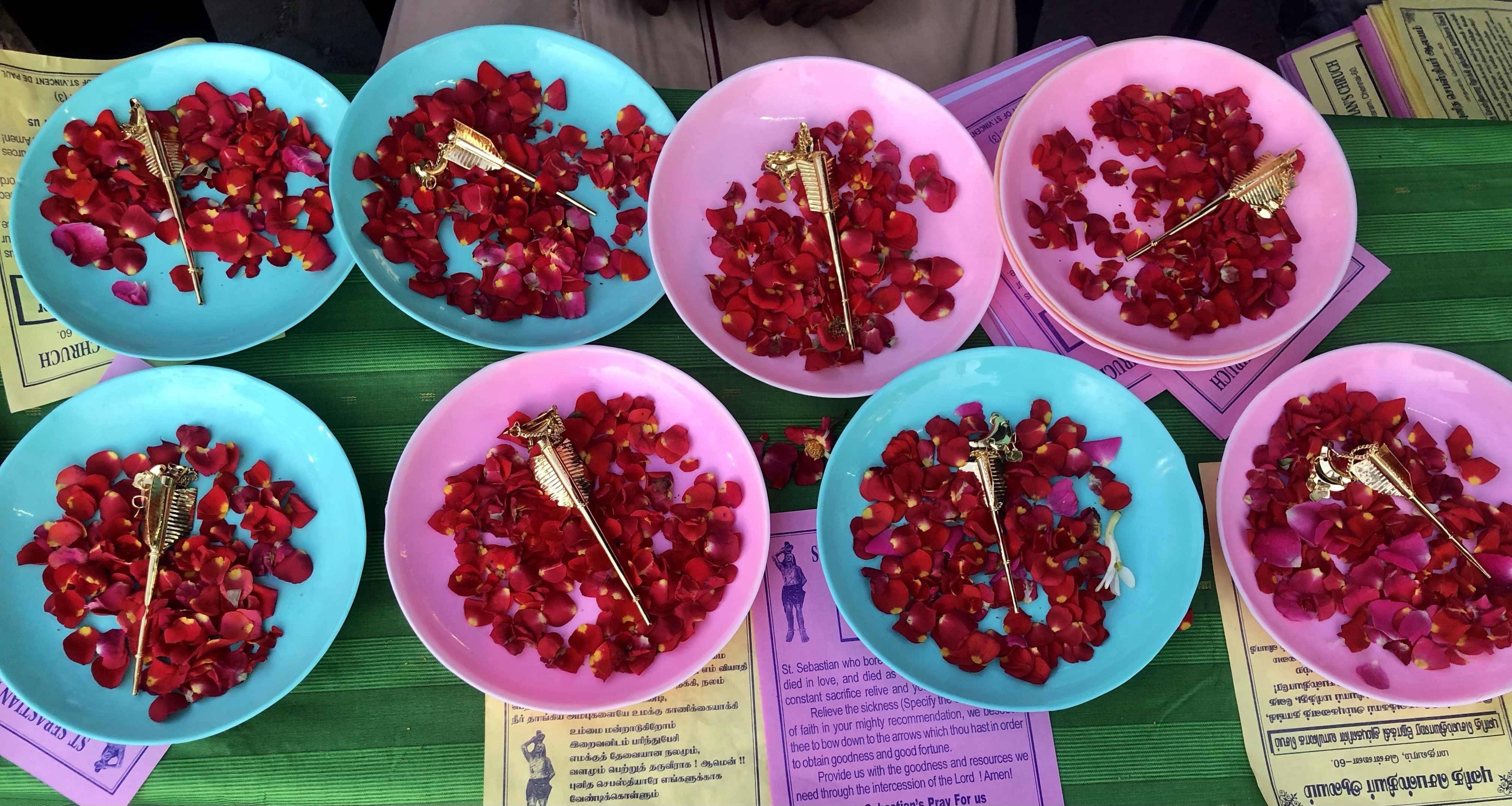


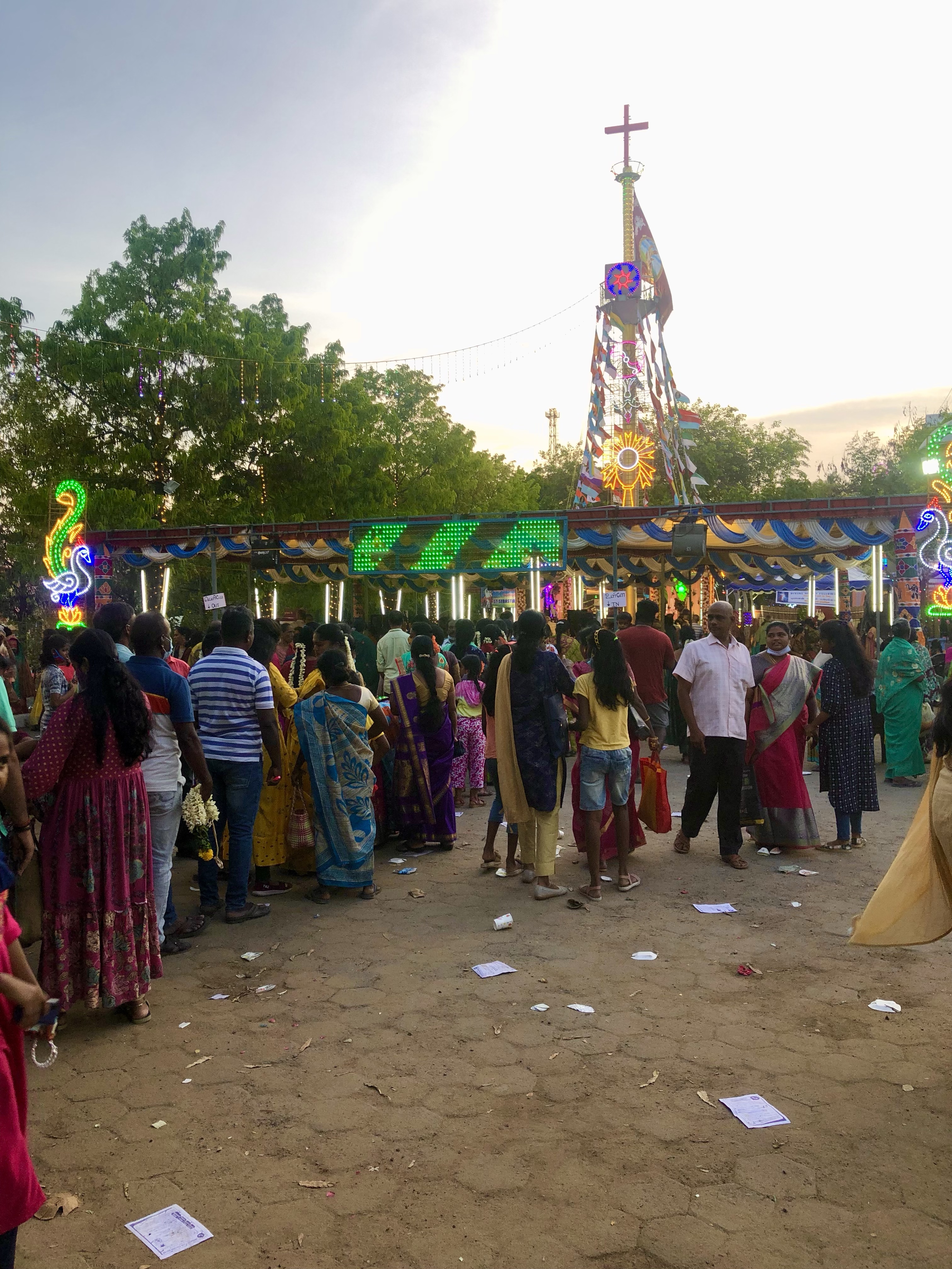
Hindu devotees do not find arrows strange or threatening because deities and figures like Rama, Arjuna, Abhimanyu, Dronacharya, Kamadeva, etc. are depicted heroically with bows and arrows. This attributive mutuality and Sebastian’s remarkable survival story became ample grounds for deification.
To delineate the realms of sainthood and godhood, and because Christian hamartiology, soteriology, and thanatology would be lost on those unacquainted with the synopsis of the gospels, the parish pitches information booths whose volunteers explain that Sebastian isn’t god, but someone who lived and died for the love of God.
That the Christian God died is a hard pill to swallow because gods and superheroes aren’t supposed to die, the Parish Priest says. In case you haven’t noticed, ours is a movable feast that doesn’t coincide with the ecclesiastical feast of St. Sebastian on 20 January, the date of his death.
Sucking on salt crystals, cracking peppercorns, and chewing kadala paruppu were popular childhood pastimes on the church campus. St. Sebastian’s pedestal always had a generous heap of salt with a smattering of peppercorns and Bengal gram for the serious consumption of adults and the amusement of children. As a sacramental, salt is used in the sprinkling rite. In the Old Testament, it was cast into sacrificial fires. It is also considered a magic bullet for skin conditions. For one, more, all, or none of these reasons—the last of which is especially compelling, given the origin story—salt became a customary offering to St. Sebastian.

As a reward for their patience in a line that never seems to end or move, the givers of arrows, salt, garlands, and shawls receive complimentary buns and roses.
Metal sheets embossed with body parts as well as metal miniatures of body parts or cradles are offered in thanksgiving or expectation—by people cured of skin diseases, injuries, and disabilities or hoping for a cure from the same, as well as parents blessed with children and spouses longing for a child. This practice also prevails in the Basilica of Our Lady of Good Health in Nagapattinam where such offerings are displayed in a museum where they bear silent witness.
Speaking of which, St. Sebastian’s Church maintains scrupulous records of testimonies. Witness files account for miracles, both little and big: relief from daily difficulties, resolution of existential crises, job placements, VISA approvals, and many more.
Far from being wary and disillusioned in the aftermath of the pandemic during which India ranked third in total deaths and second in total cases, the crowds are hopeful. According to Fr. Simon, there are two groups of post-pandemic pilgrims: those grateful for surviving death, and those seeking protection from it.
After two years, pilgrims can finally approach the concave façade that gives one the distinct feeling of walking into an open embrace. Seeing a demolished, then an unfinished, structure transform into a magnificent house of worship redoubles our hope, particularly after the devastations of the pandemic.
You shall have a song as in the night when a holy feast is kept. (Isaiah 30:29)
Days 7-8: 23-24 April (Saturday-Sunday)
Every day I check the pamphlet for the agenda. It’s crowded and colorful—just like the pageantry of faith and festivity on the church campus and Madhavaram High Road.
This is an exceptional weekend when vehicles are at the mercy of pedestrians, when vacant plots wake up as fairgrounds, when the middle of nowhere feels like the center of the world.
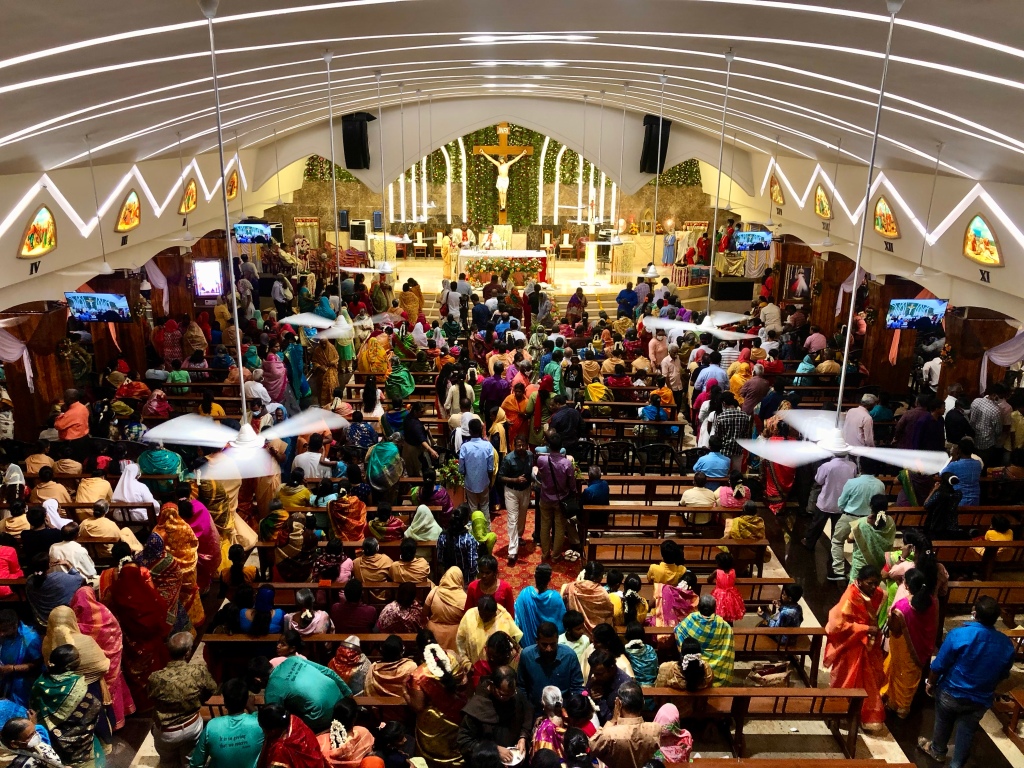
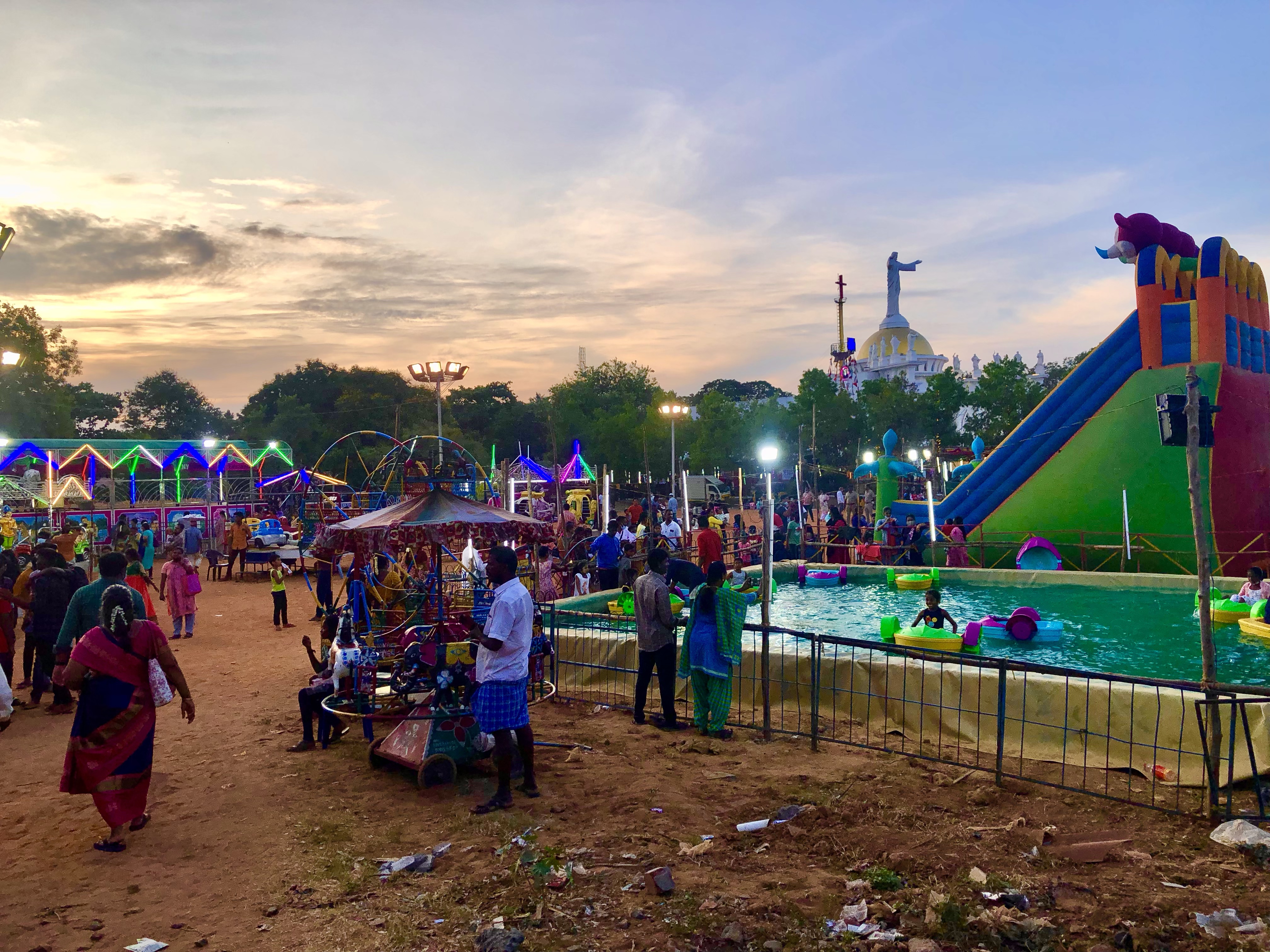
Stalls stand cheek by jowl on both sides of the road. The tantalizing aromas of boiled corn, tandoori, shawarma, and poppadoms travel in all four cardinal directions. Dreadlocked gypsies sell catapults; nursing mothers with jeweled noses and ears sit among plastic guns, binoculars, and choppu saman their children might never play with; a turbaned man waves palm-leaf fans in the air while balancing a stack of them on his head. There’s colorful ceramic tableware with spartan kitchen steel, Catholic pictures with puja paraphernalia, halwa and pumpkin petha with salted and spiced potato chips.
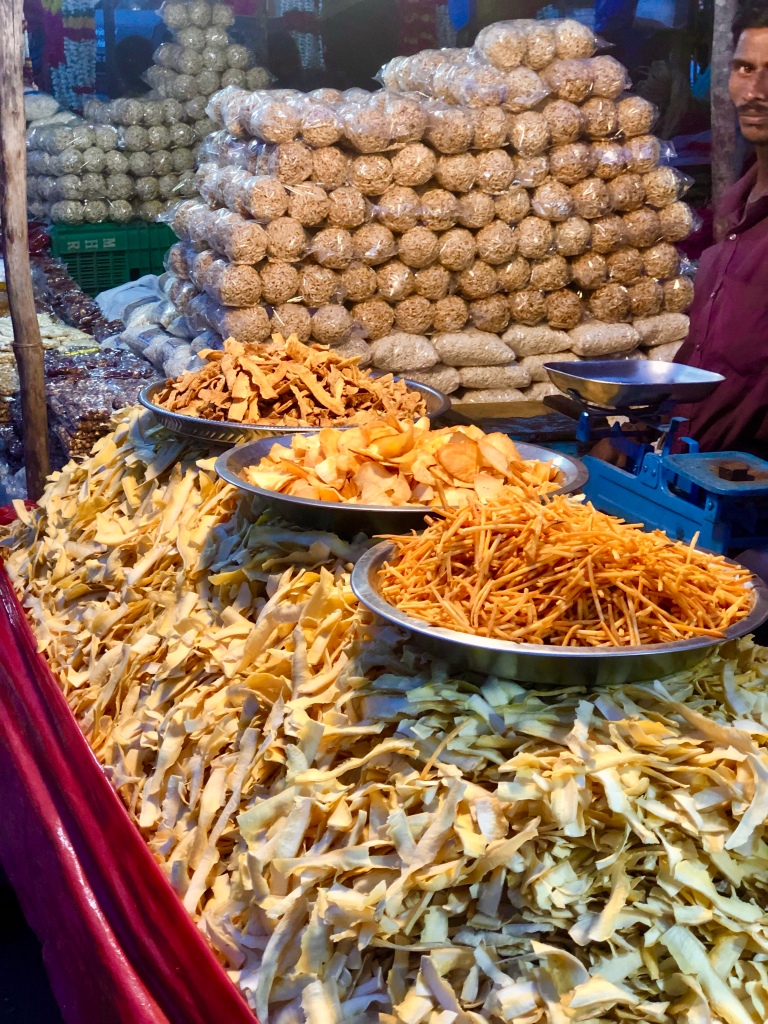
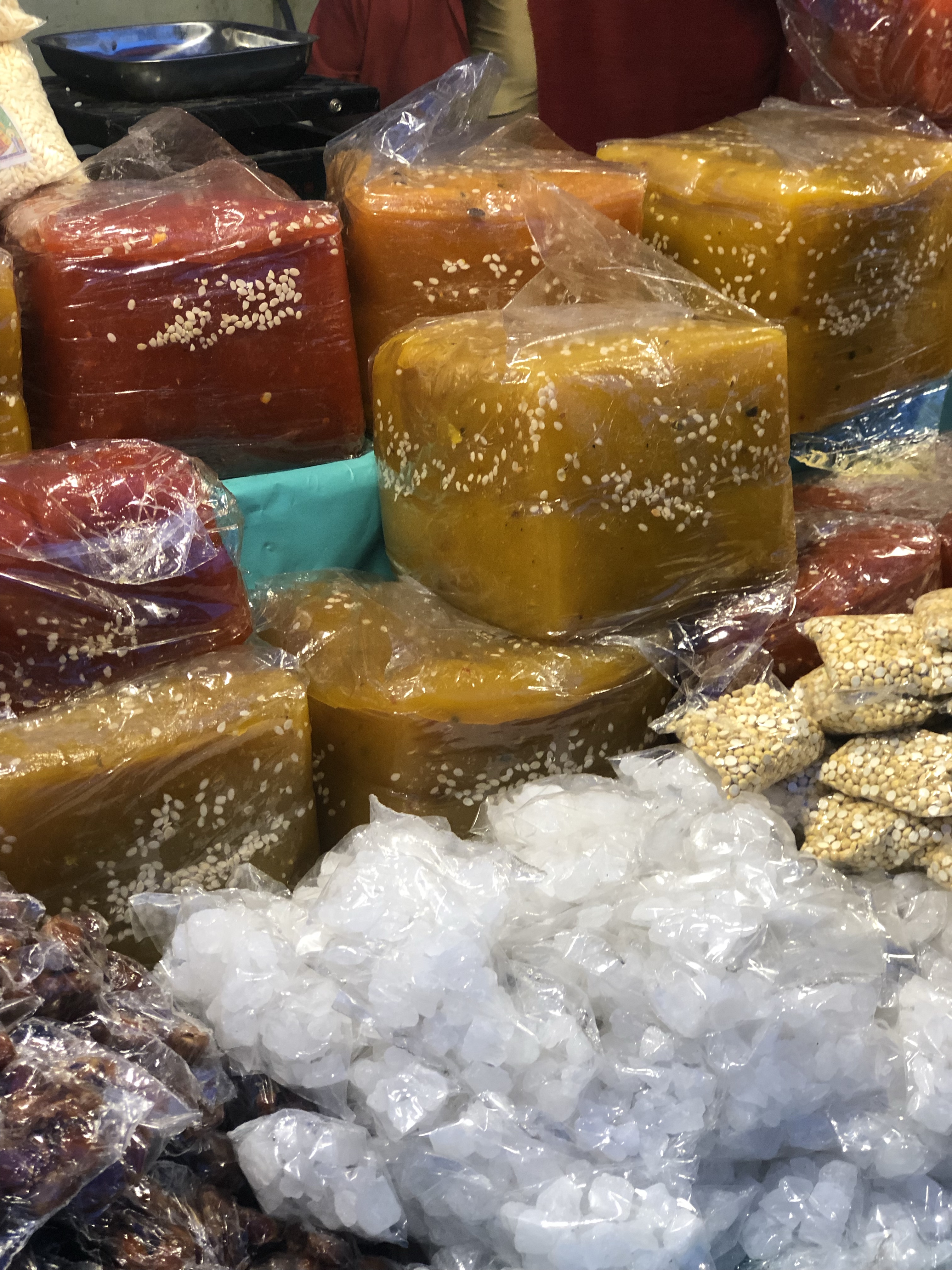
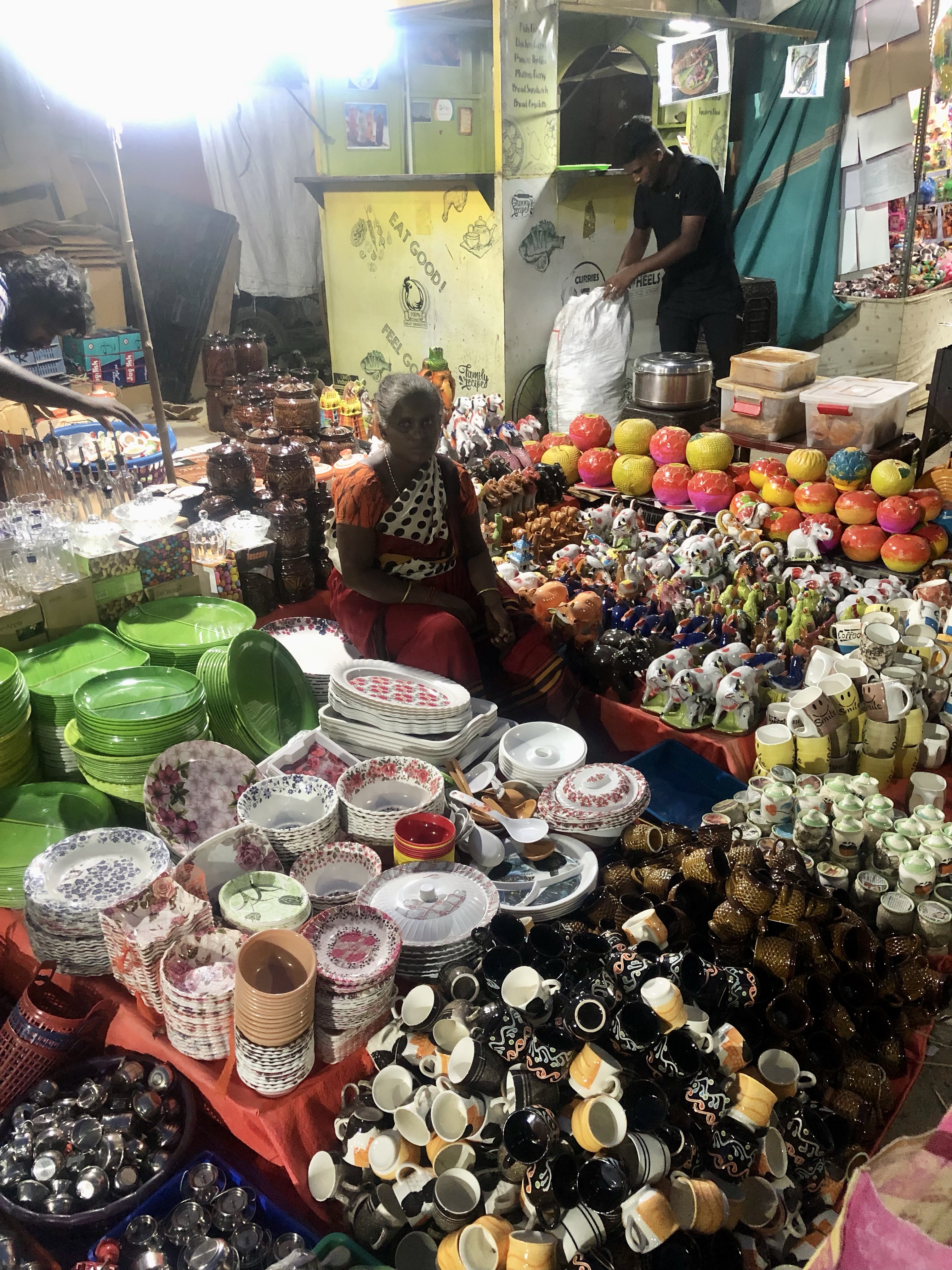


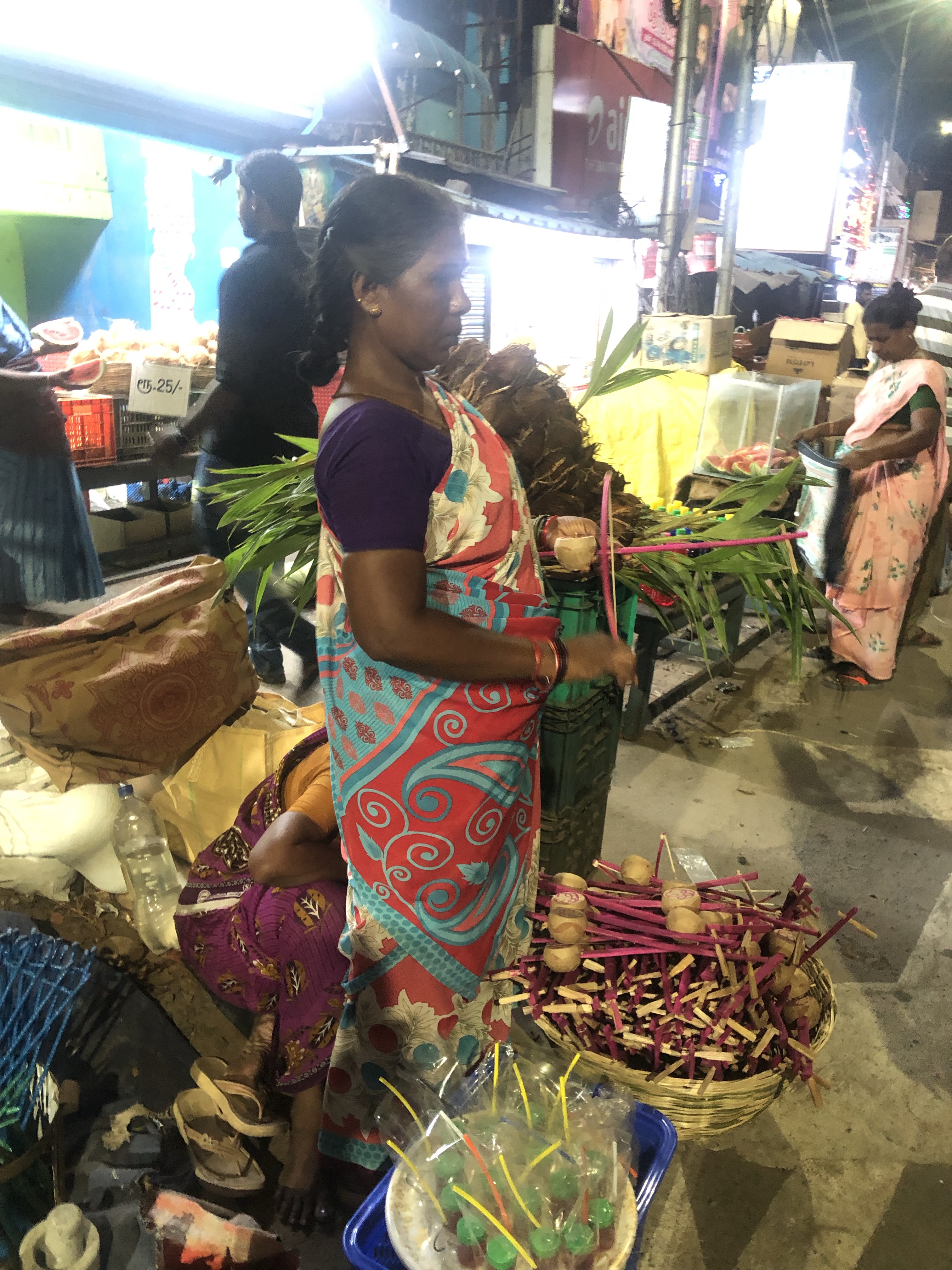
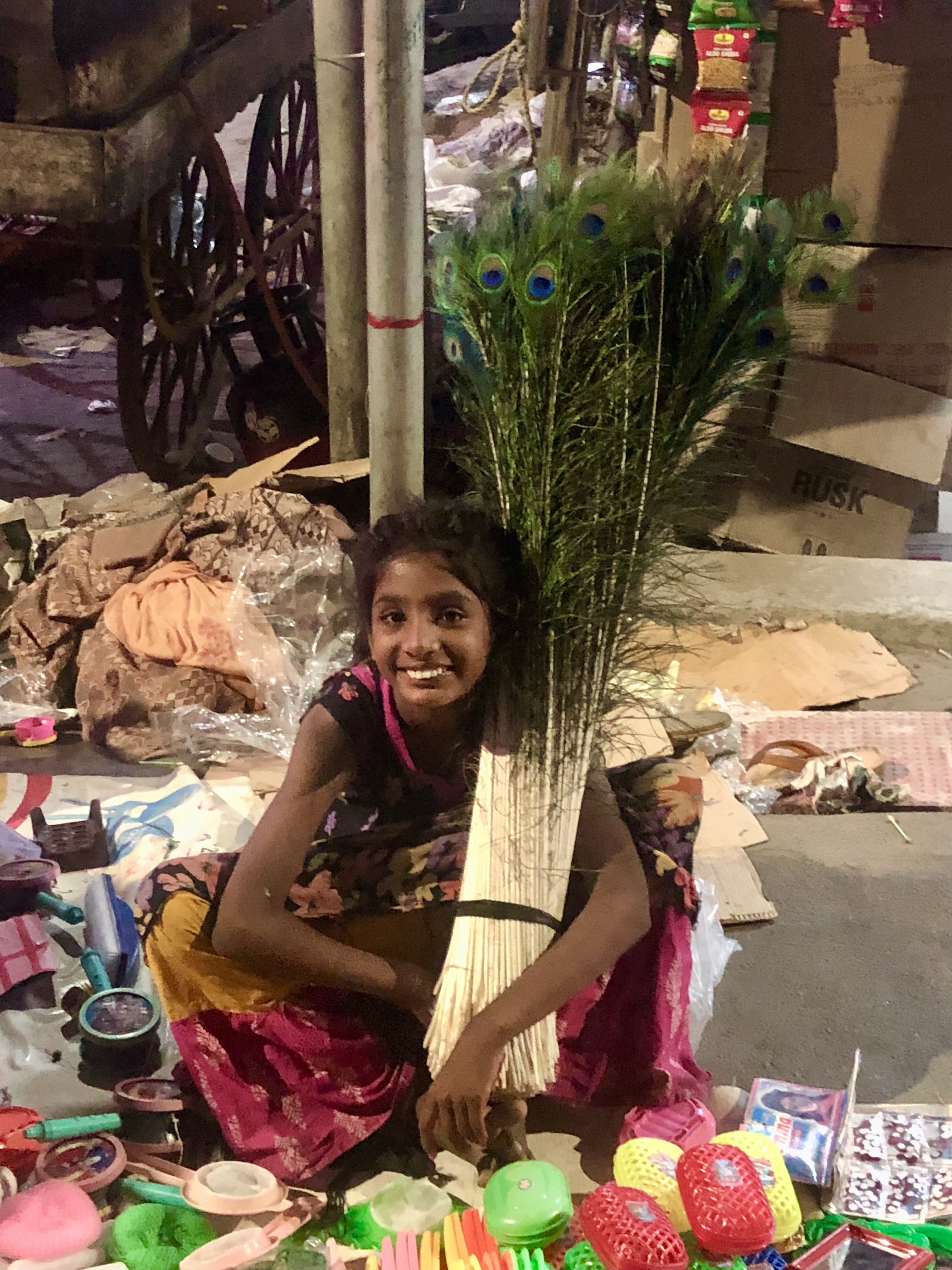
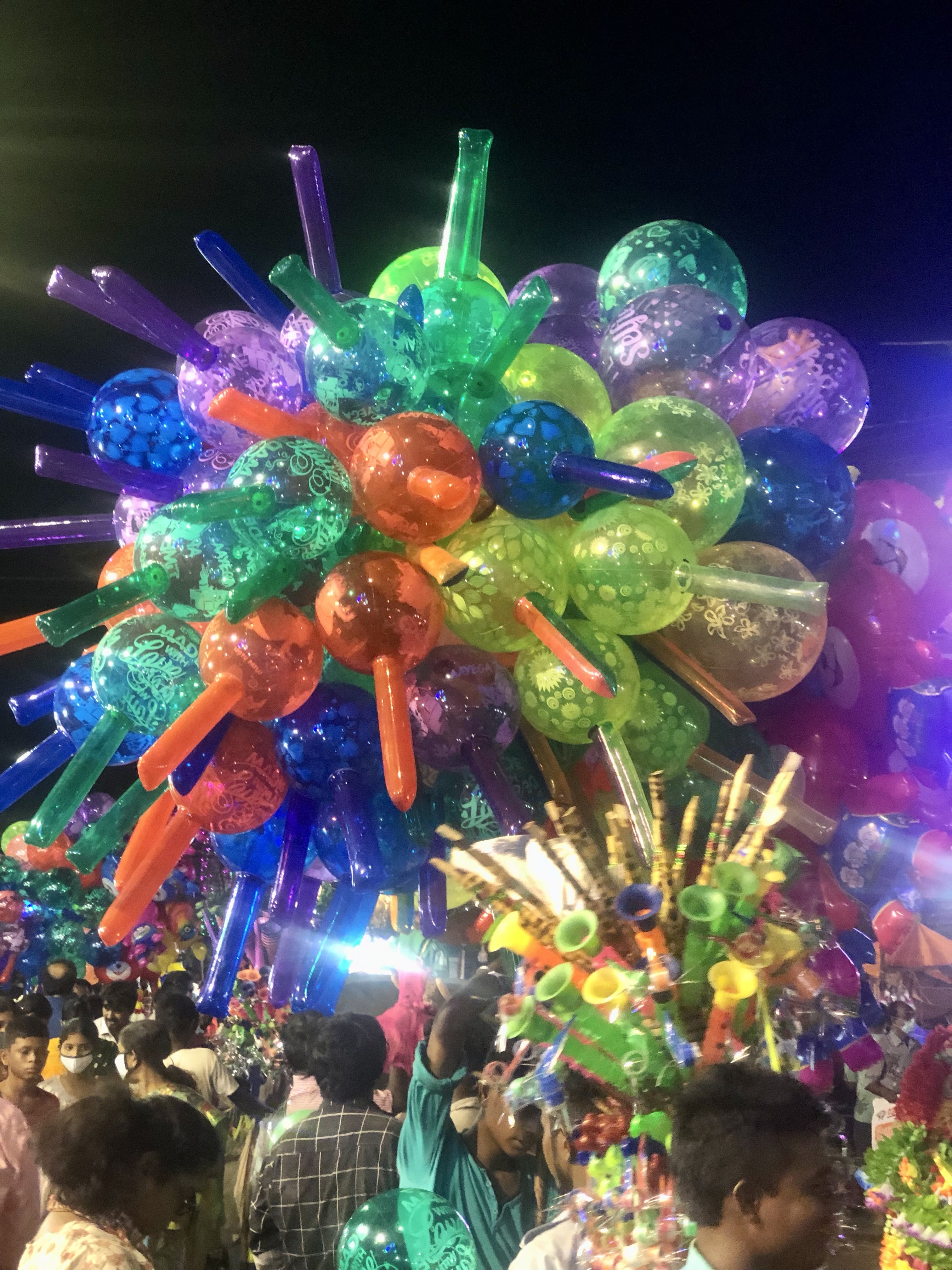
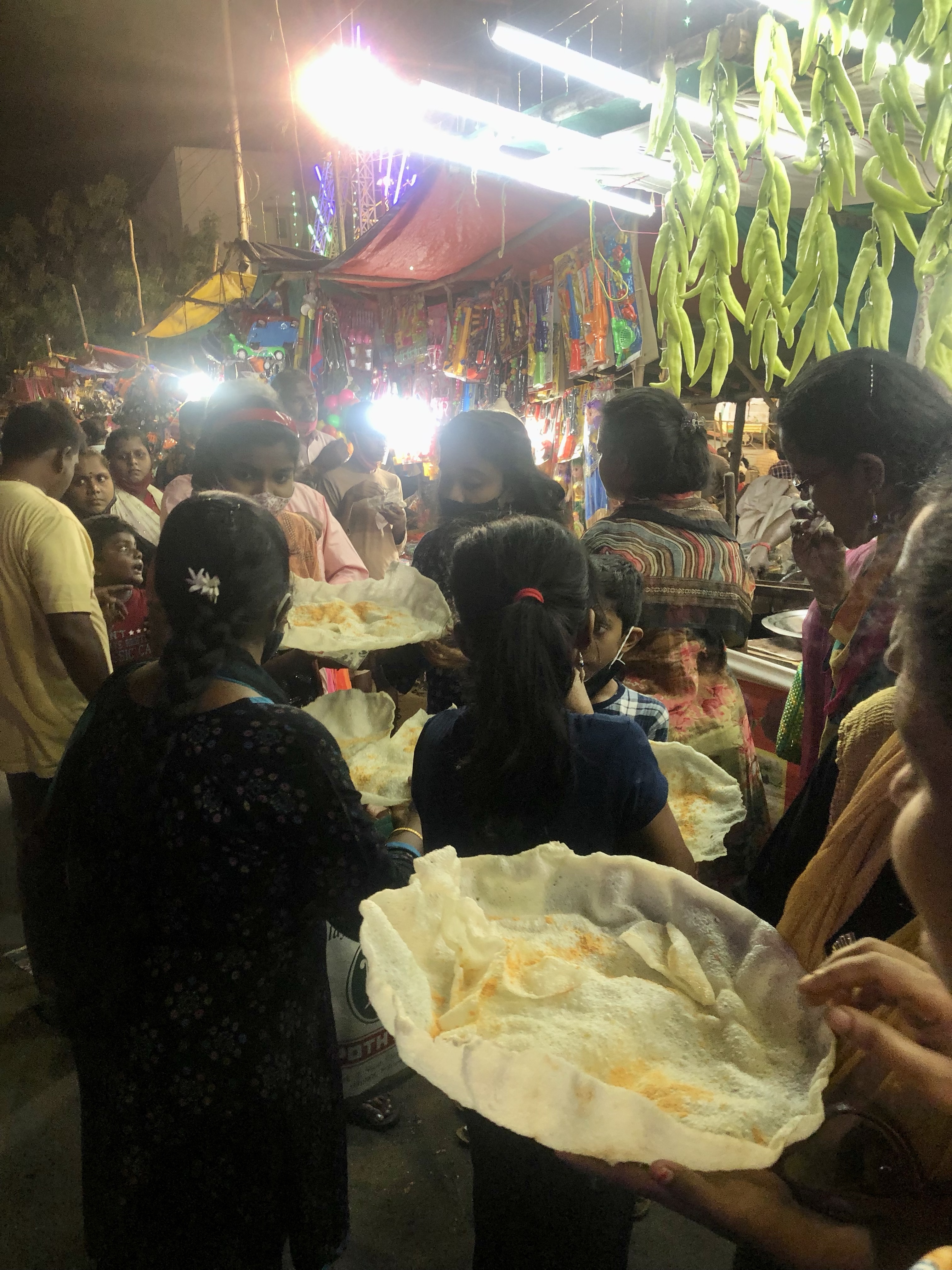
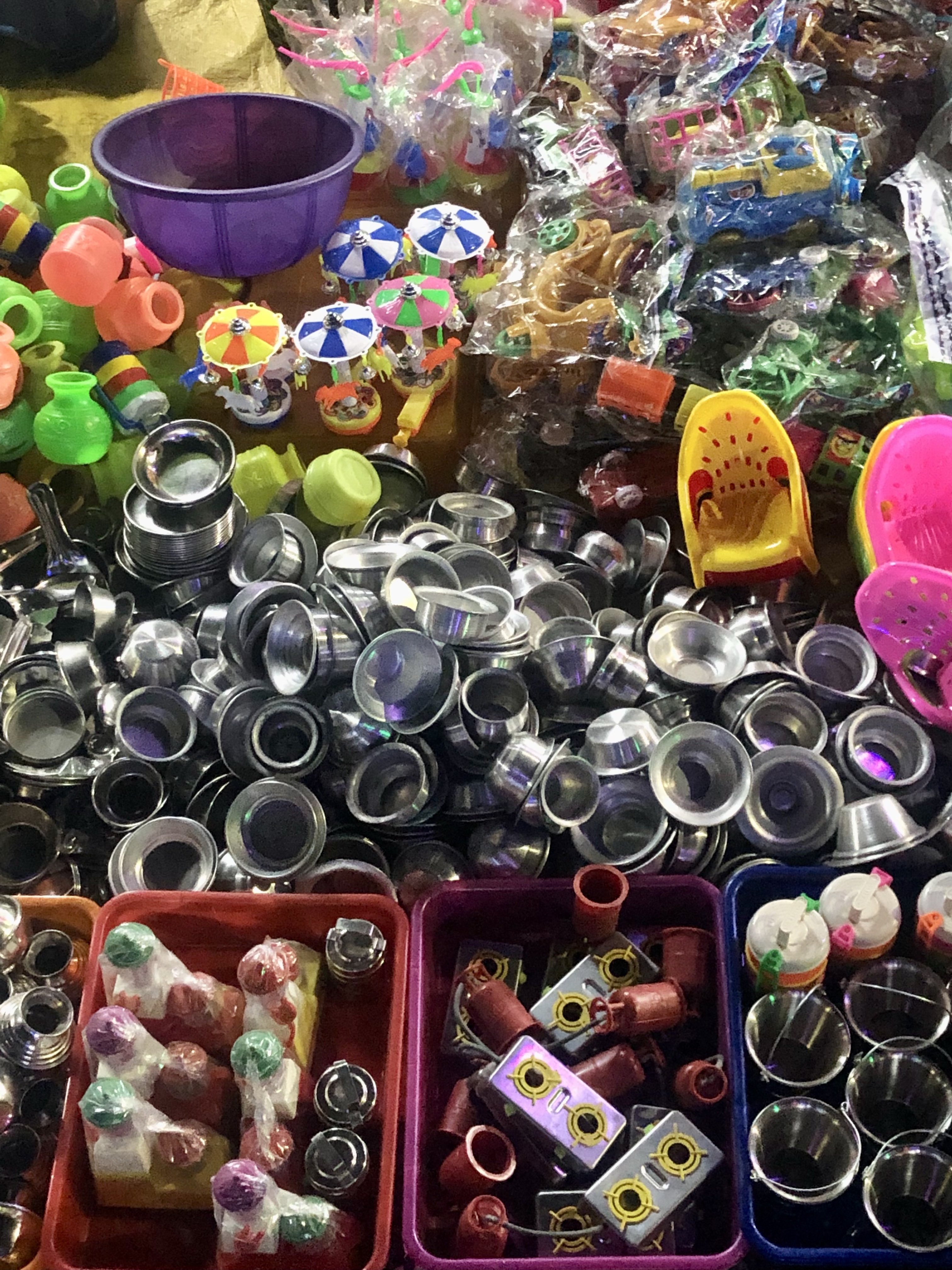
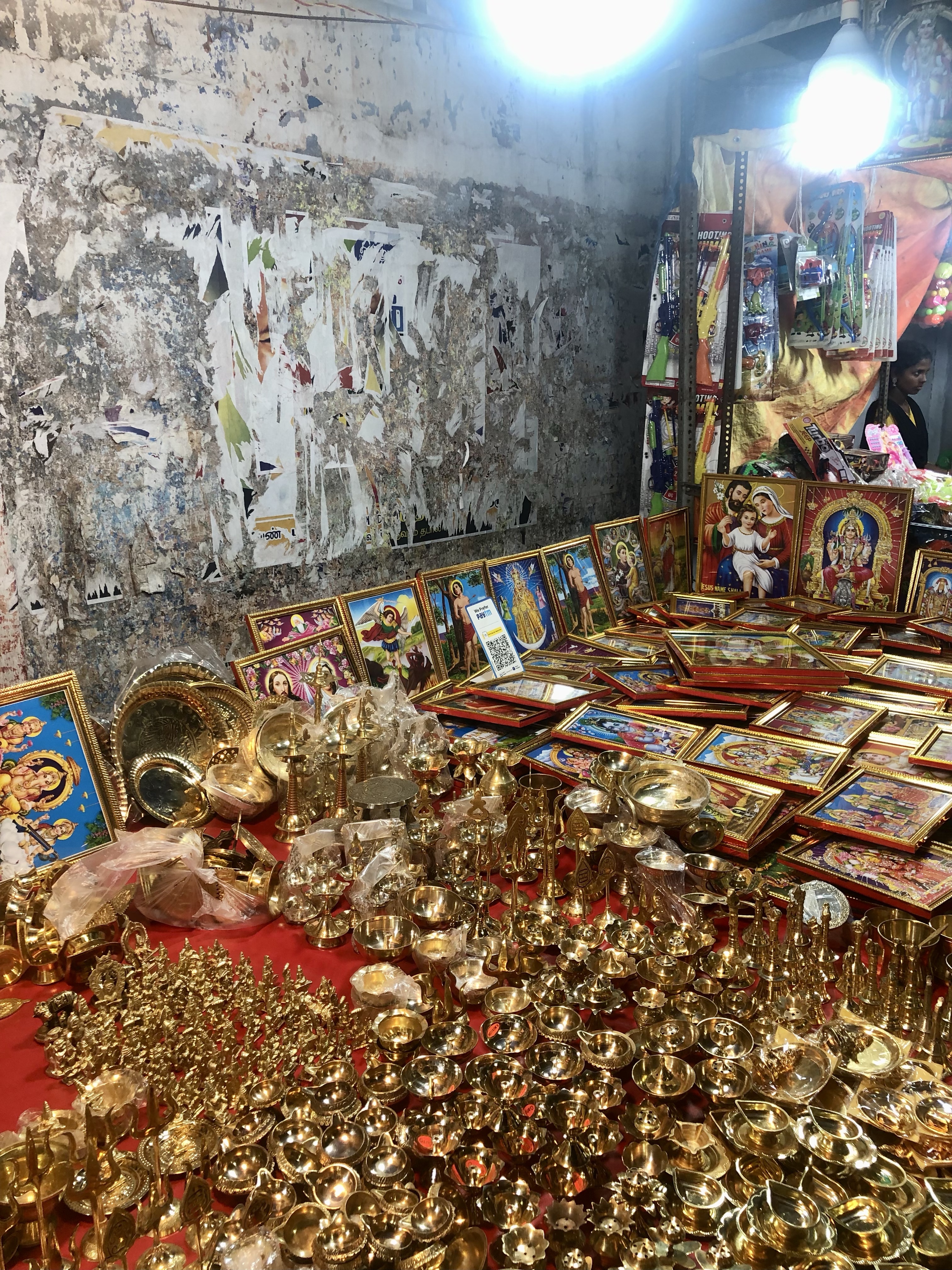
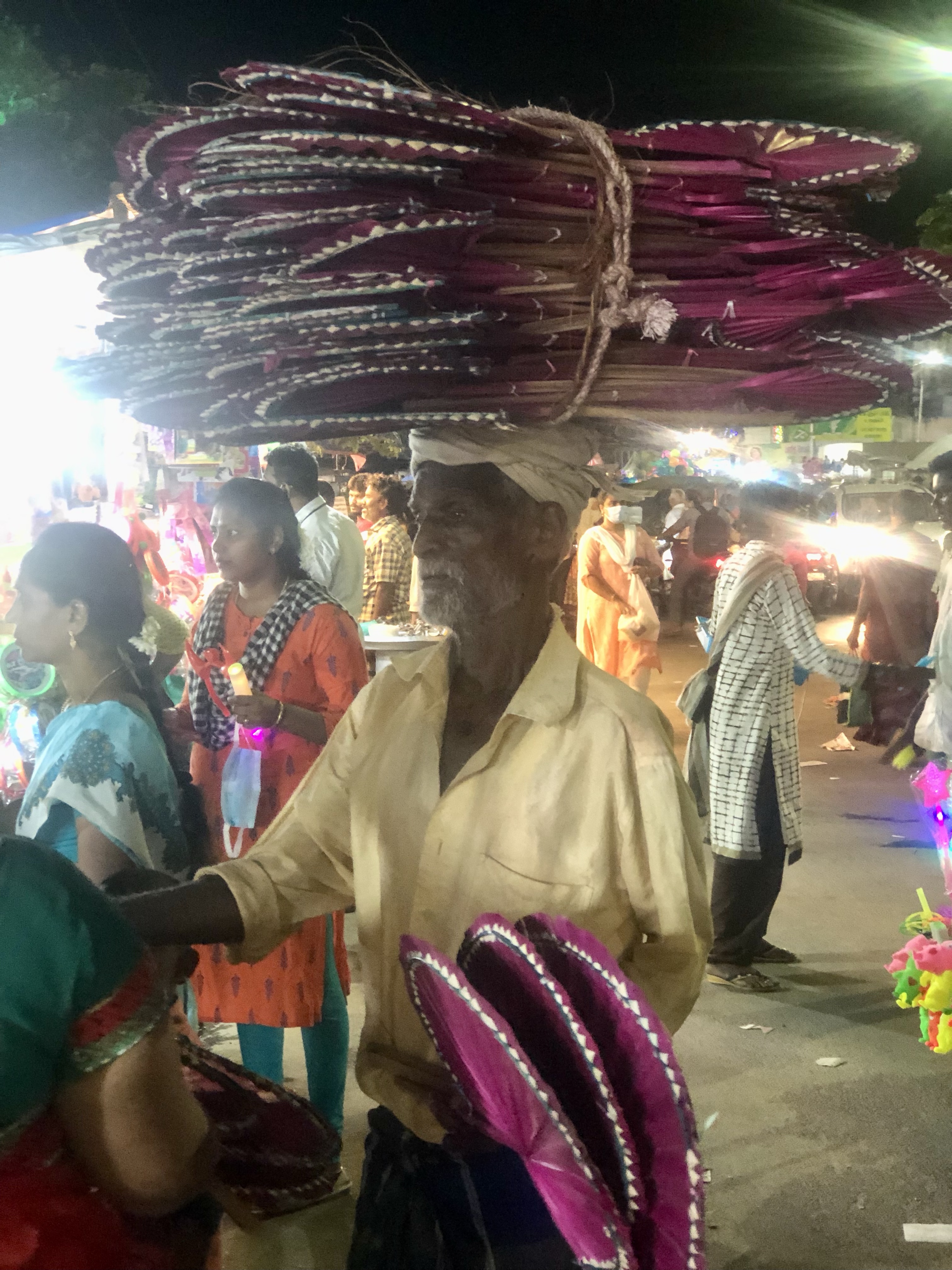
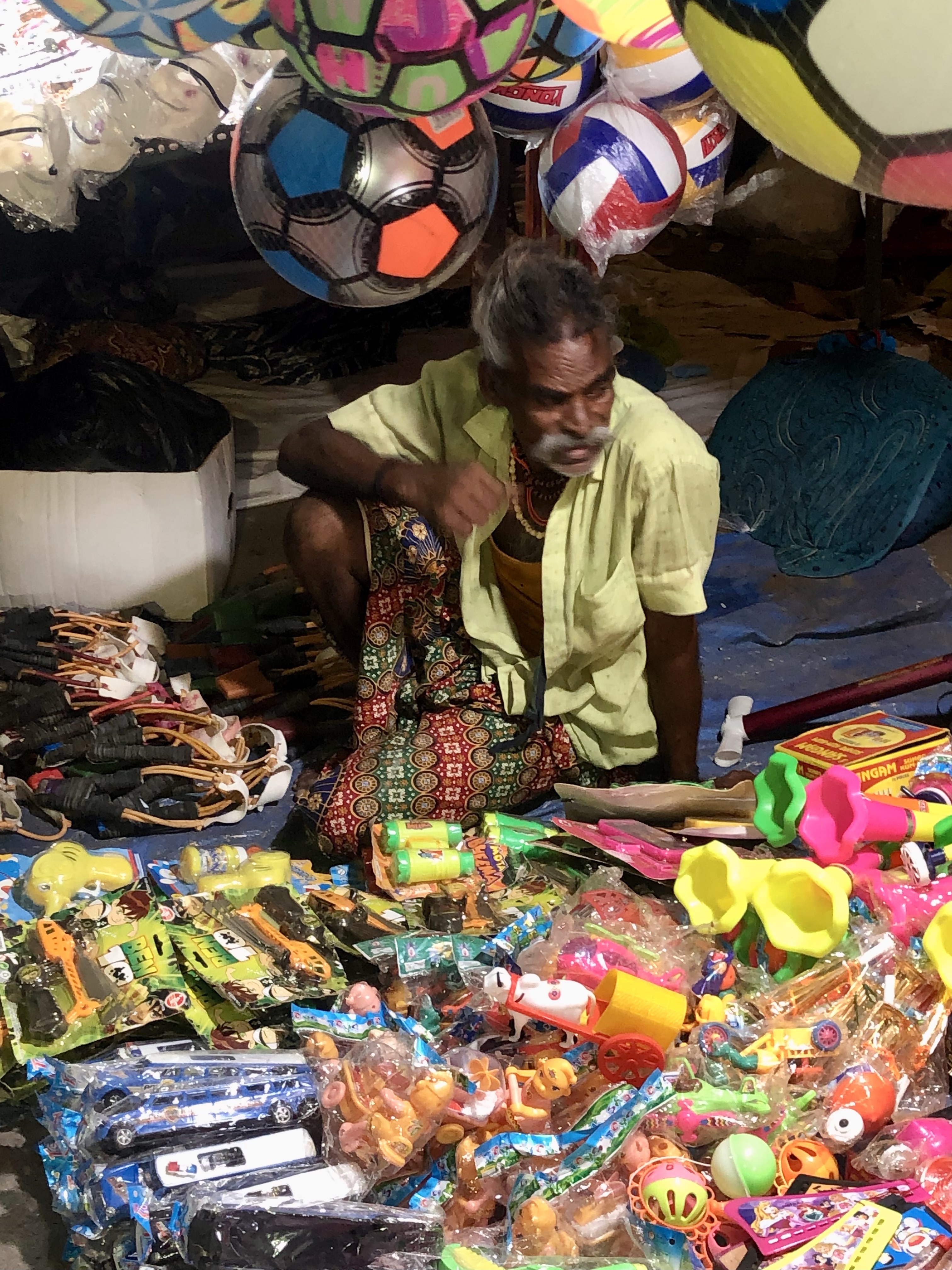
The inauguration of the procession brings the church campus to a fever pitch so high the air flexes. Crowds swell around the three chariots. When he’s not hunting demons or unwinding in the friary, Michael the Archangel is a special guest at annual processions. Next in line is Mary, graceful and silent, smiling down on her clamorous children. Lastly, Sebastian, the saint behind the sensation.

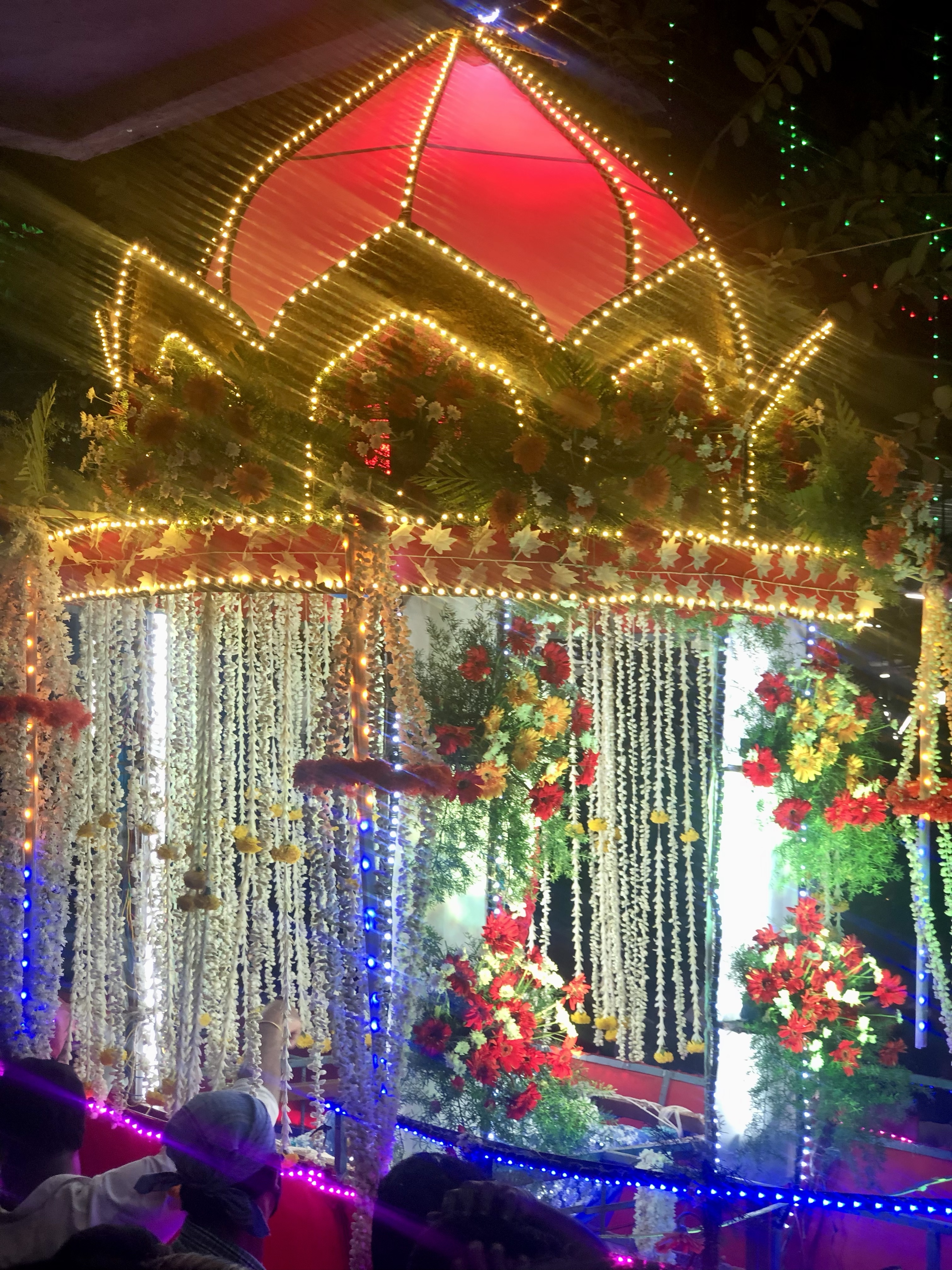
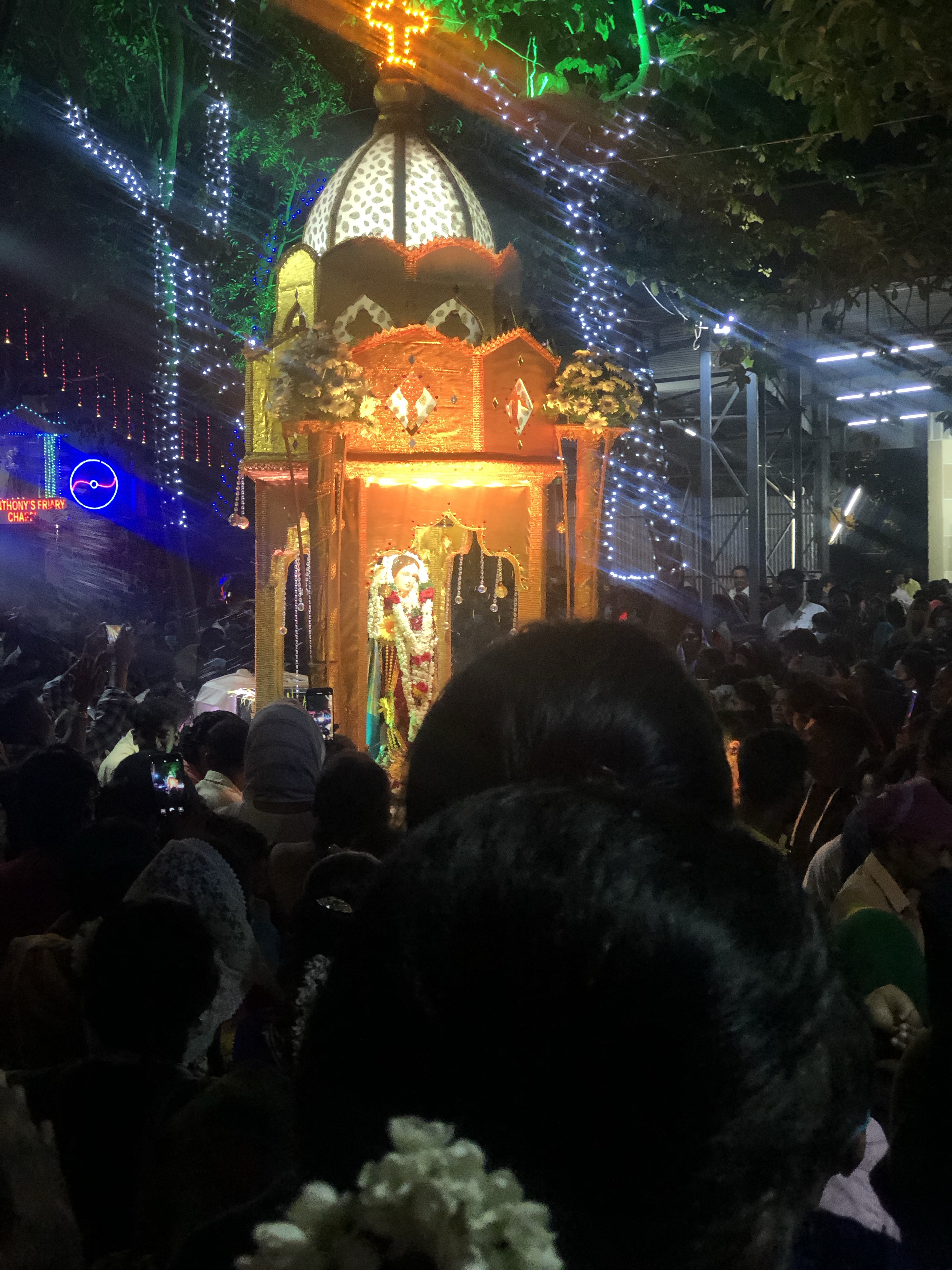
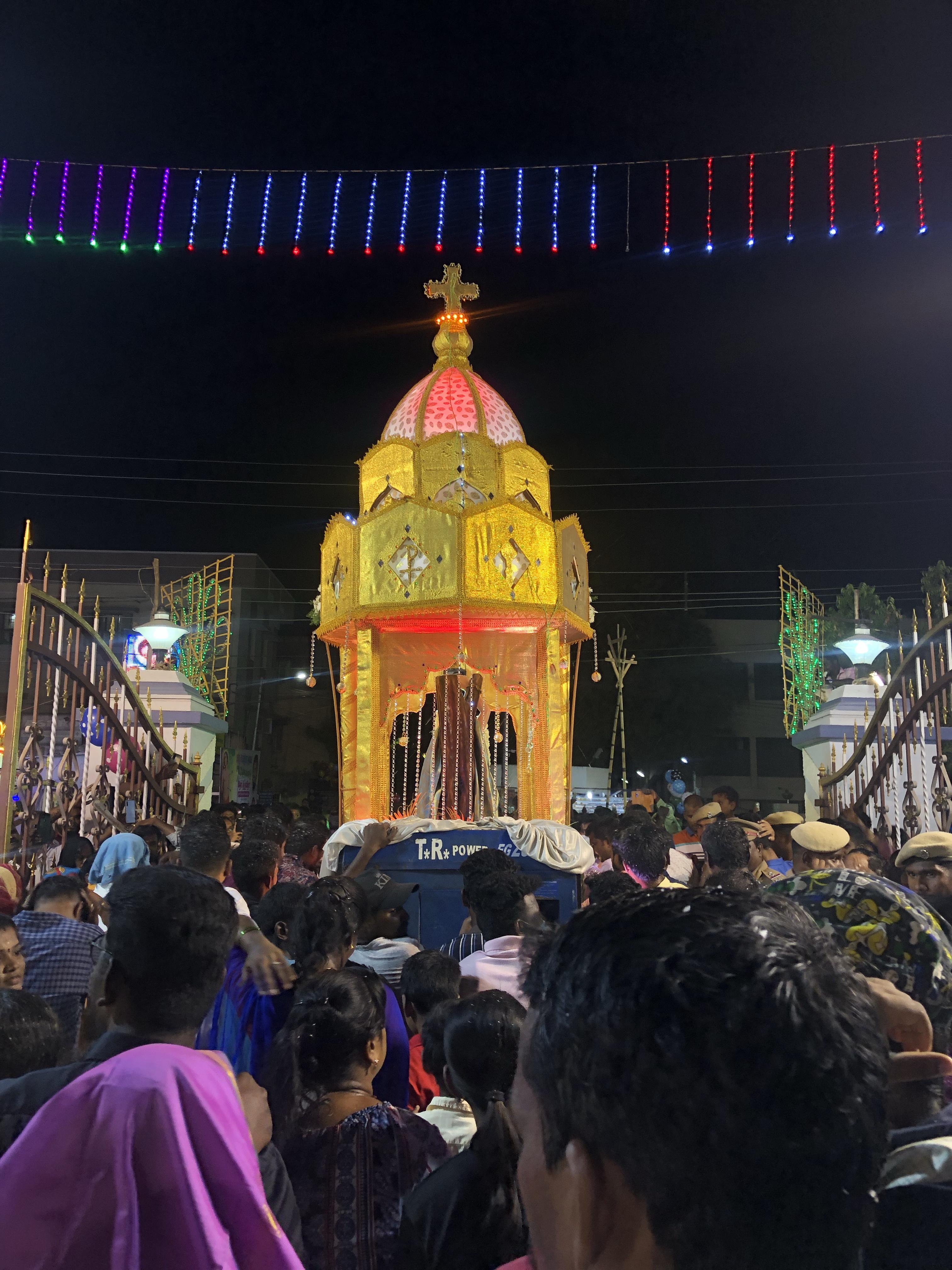
This long-legged, quick-footed human gets the hang of patience when what is otherwise a ten-minute walk stretches into a four-hour waddle.
When the engine of St. Sebastian’s chariot blows its diesel breath on my face and neck, I wonder how the woman beside me isn’t stewing in her silk sari.
There are frequent showers of salt, rose petals, and rice. Out of anger, humor, or for lack of a better tribute, someone hurls a plastic water bottle.

As the streets get narrower, the crowds get bigger, as do the displays of devotion. People rush out of their houses like ardent fans eager to meet their favorite celebrity. There are folks who, like Zacchaeus, choose rooftops and water tanks as their vantage points. They drape a great many ponnadai and garlands—rose, marigold, currency notes (yes, you read that right)—around Sebastian’s neck. Luckily, he’s a statue because no mortal neck could withstand the weight or heat of silk shawls in our boiler-room temperatures.
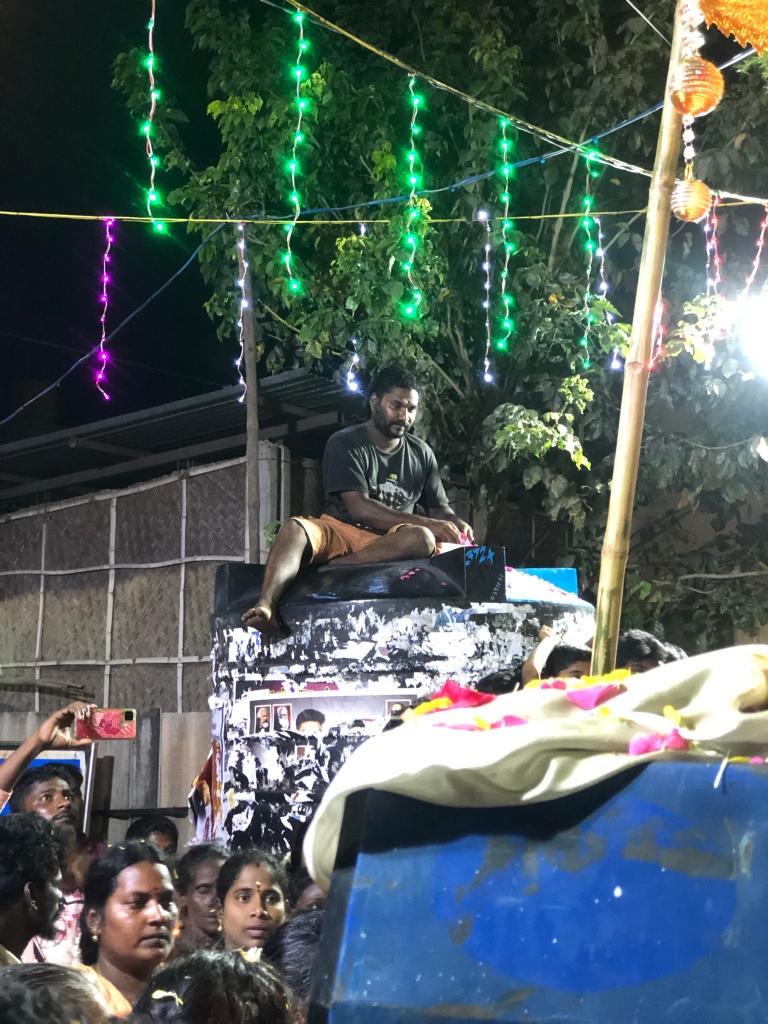

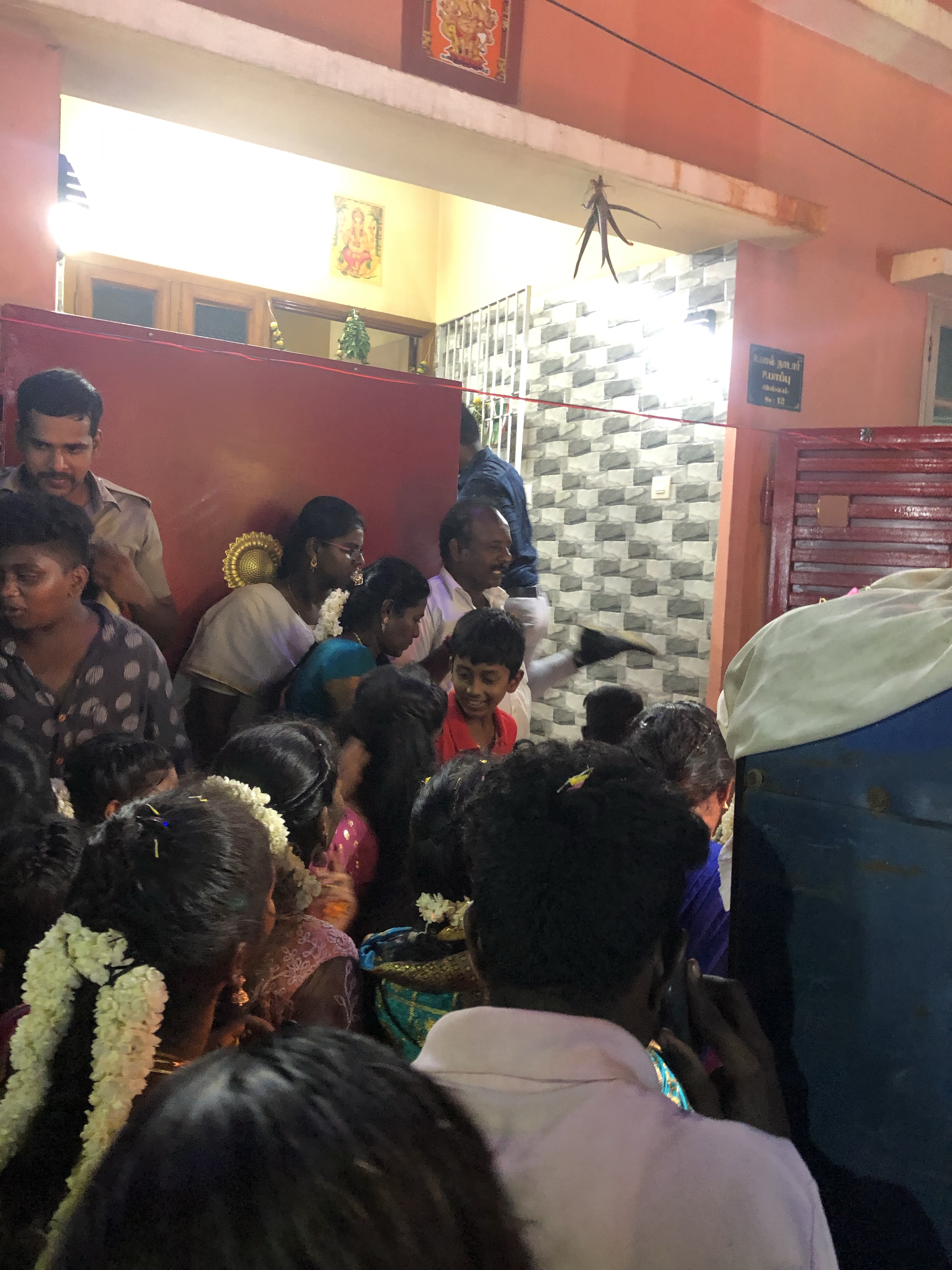
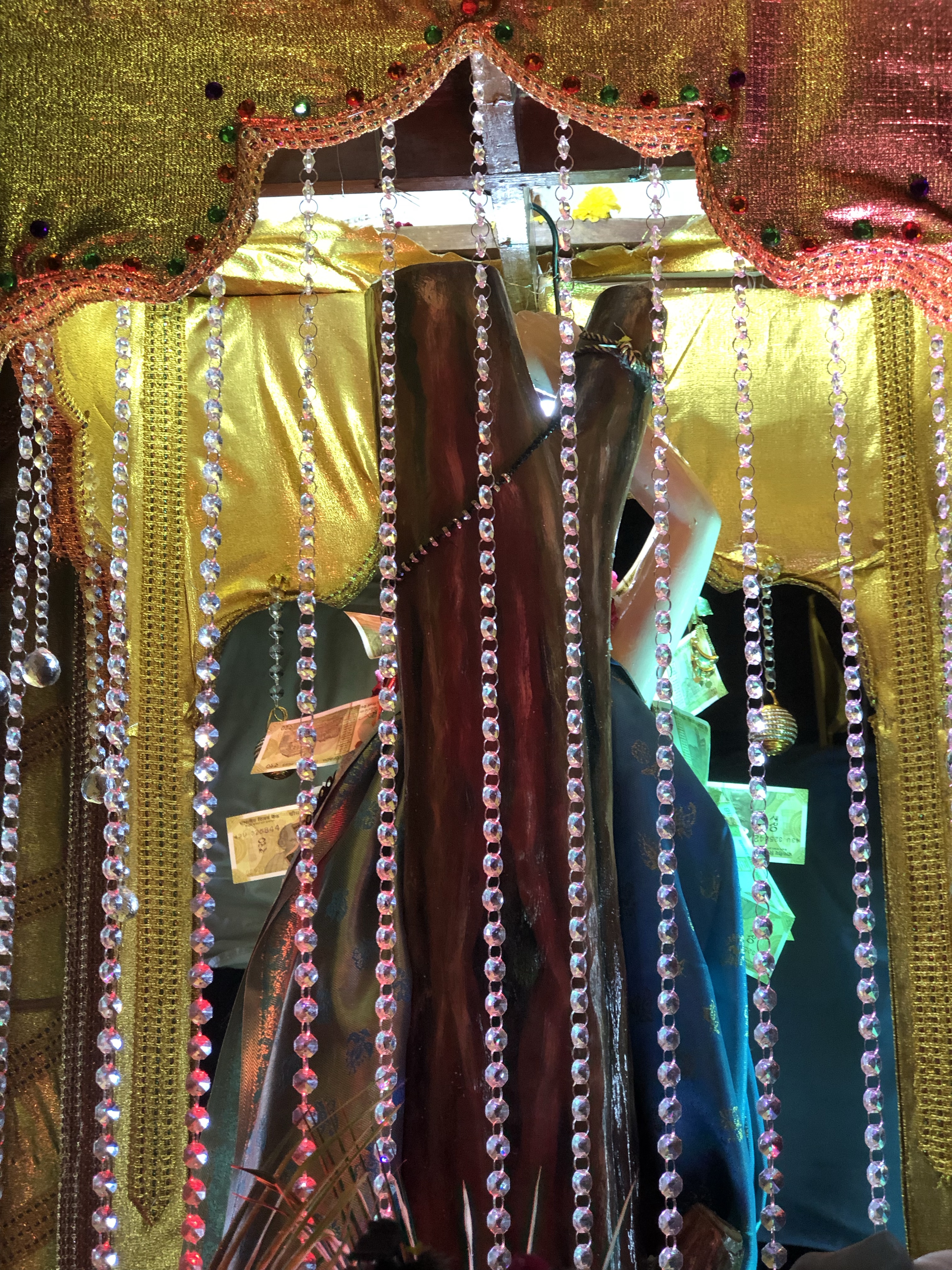
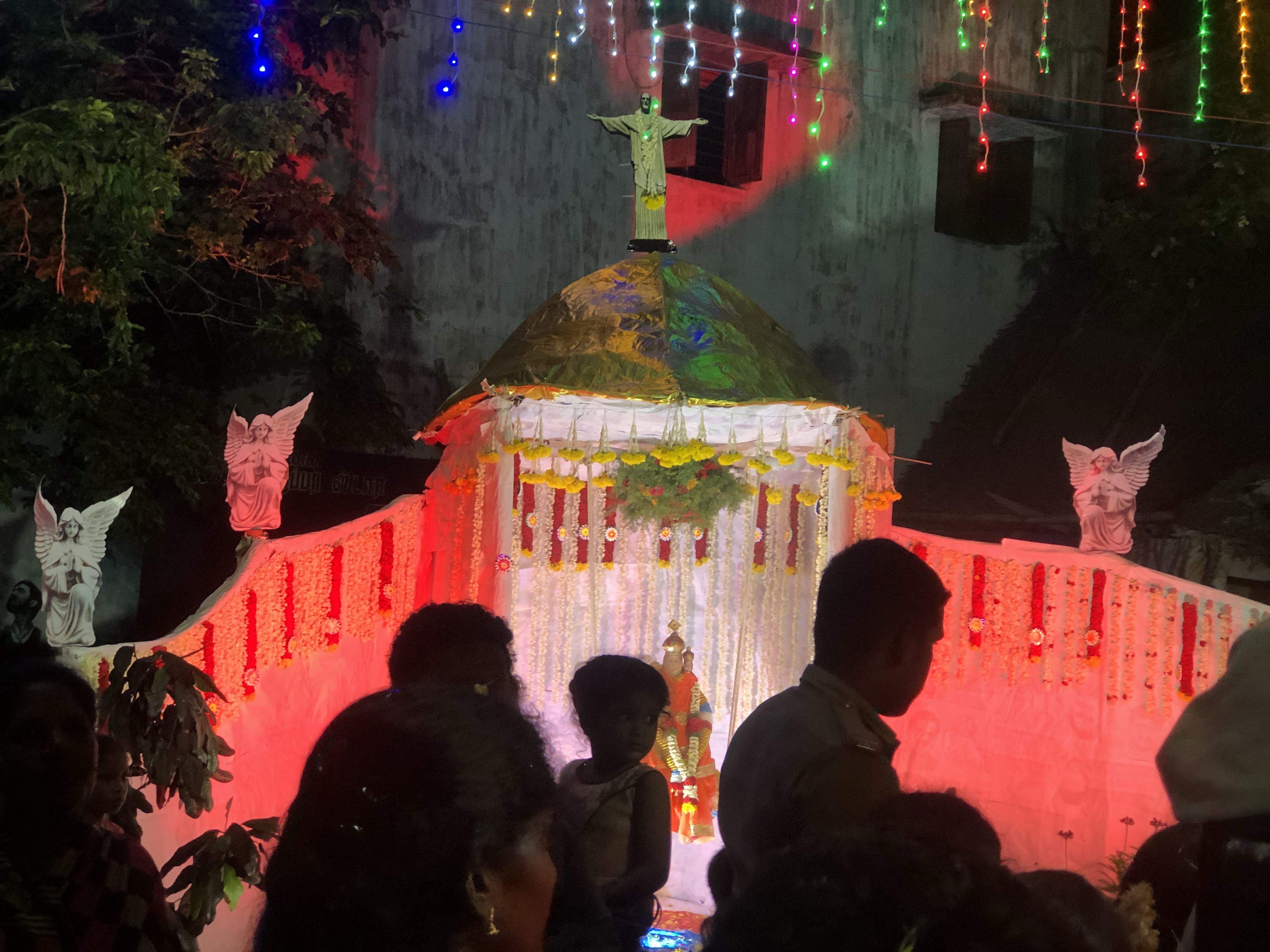
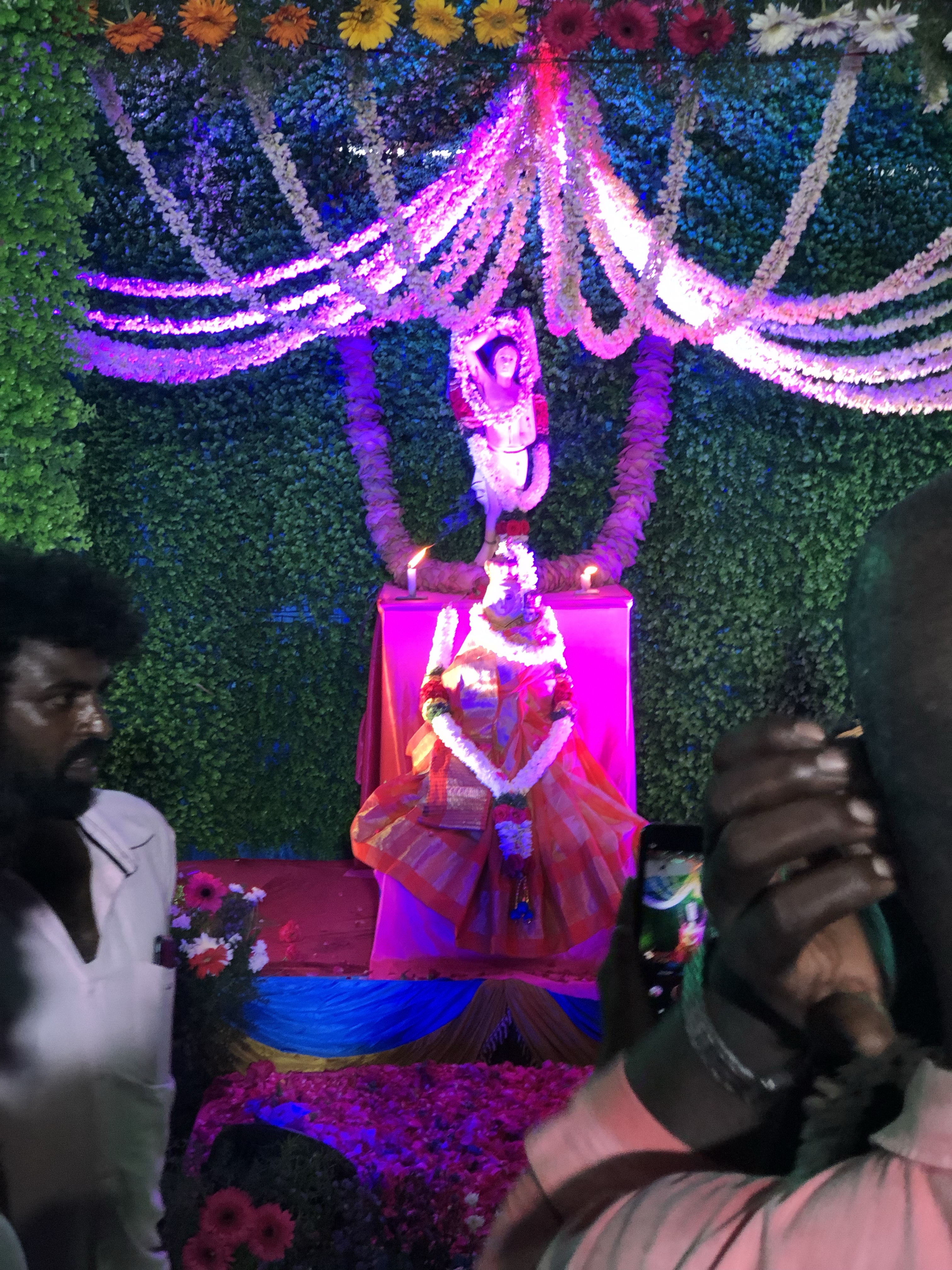
Hunger and thirst are no concern because handouts are in continuous supply: a bottle of water from here, a soda from there, fruit juice from a Christian family, and chocolate bars from a Hindu family. (What did I tell you about Indian hospitality?)
Firework extravaganzas punctuate the monotony, shooting up sparks that rival the stars. Some sparks descend like misrouted comets and fizzle out in neem branches or amid the crowd. We make pit stops at public altars and devotional displays such as the paper-and-cardboard miniature of the parish church.
Though it’s way past their bedtime, sprightly children shout, “Mariye vazhga!” Though it’s been four hours, the aged band plays jaunty tunes and twirls tasseled umbrellas. Meanwhile, geriatrics in their early twenties shuffle from one foot to another, stifle yawns, and squat on the streets or strangers’ bike seats.
For everything there is a season. (Ecclesiastes 3:1)
The Day After: 25 April (Monday)
When the clock strikes twelve, Madhavaram shakes off her festoons and finery. Tired, she falls asleep. At dawn, she rises, graced with the ordinary.
Written by Susanna Vas
Acknowledgments
Fr. Simon A. OFM, Parish Priest, St. Sebastian’s Church, Madhavaram, Chennai
Fr. Jamesmon P. C. OFM, Assistant Parish Priest, St. Anthony’s Friary Church, Bangalore
